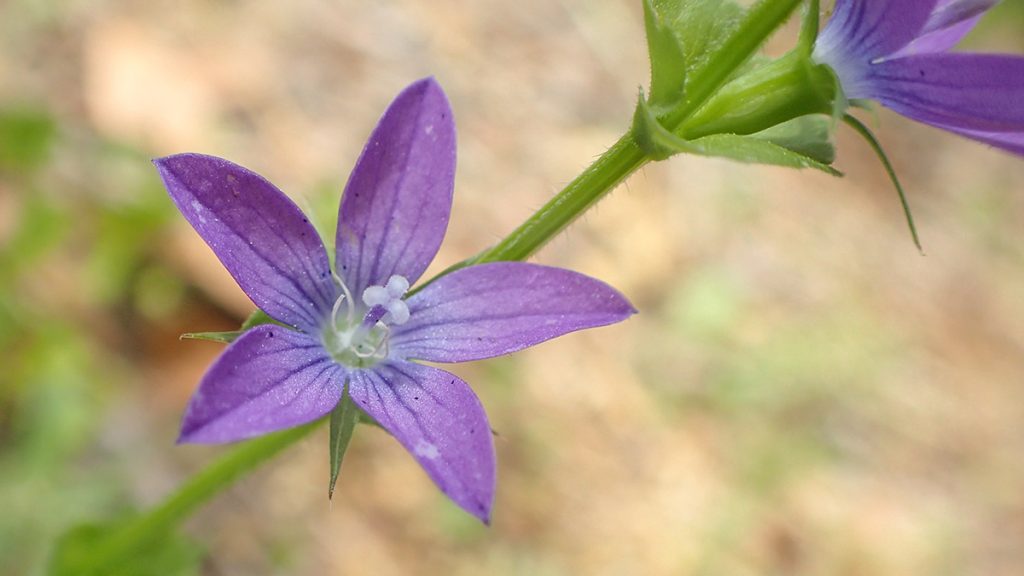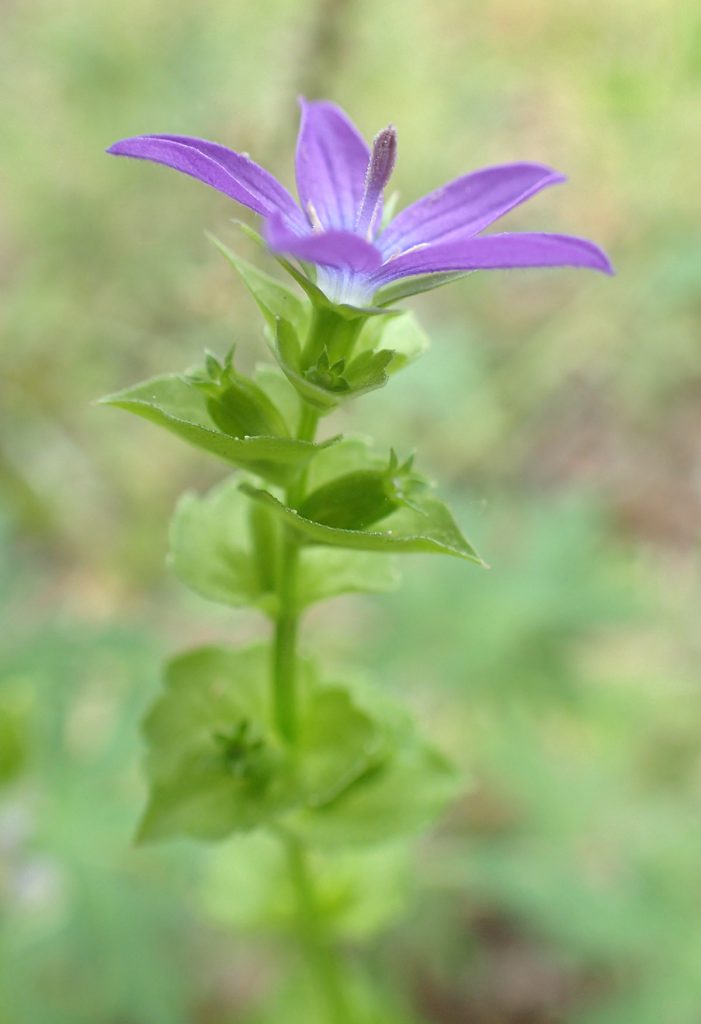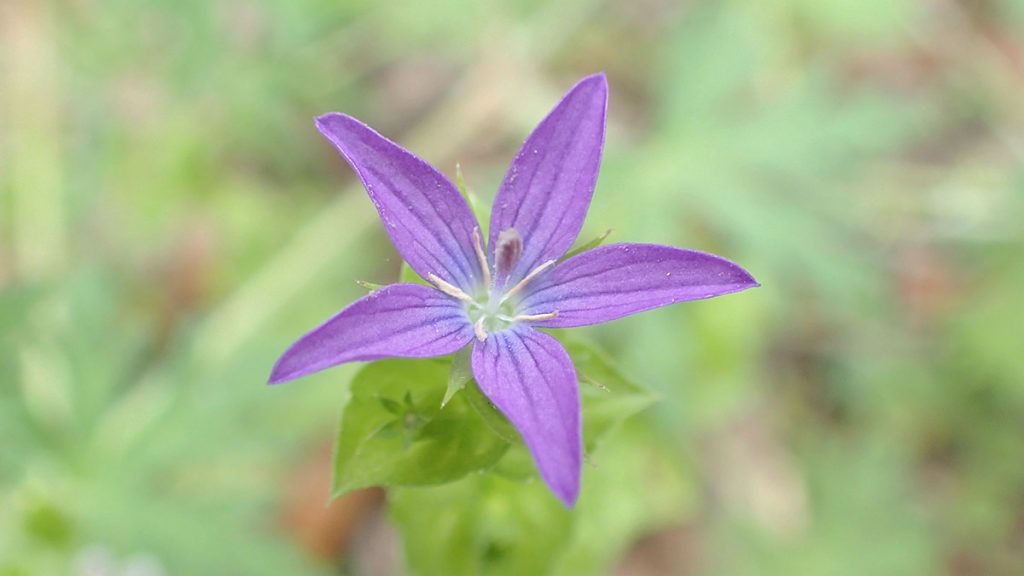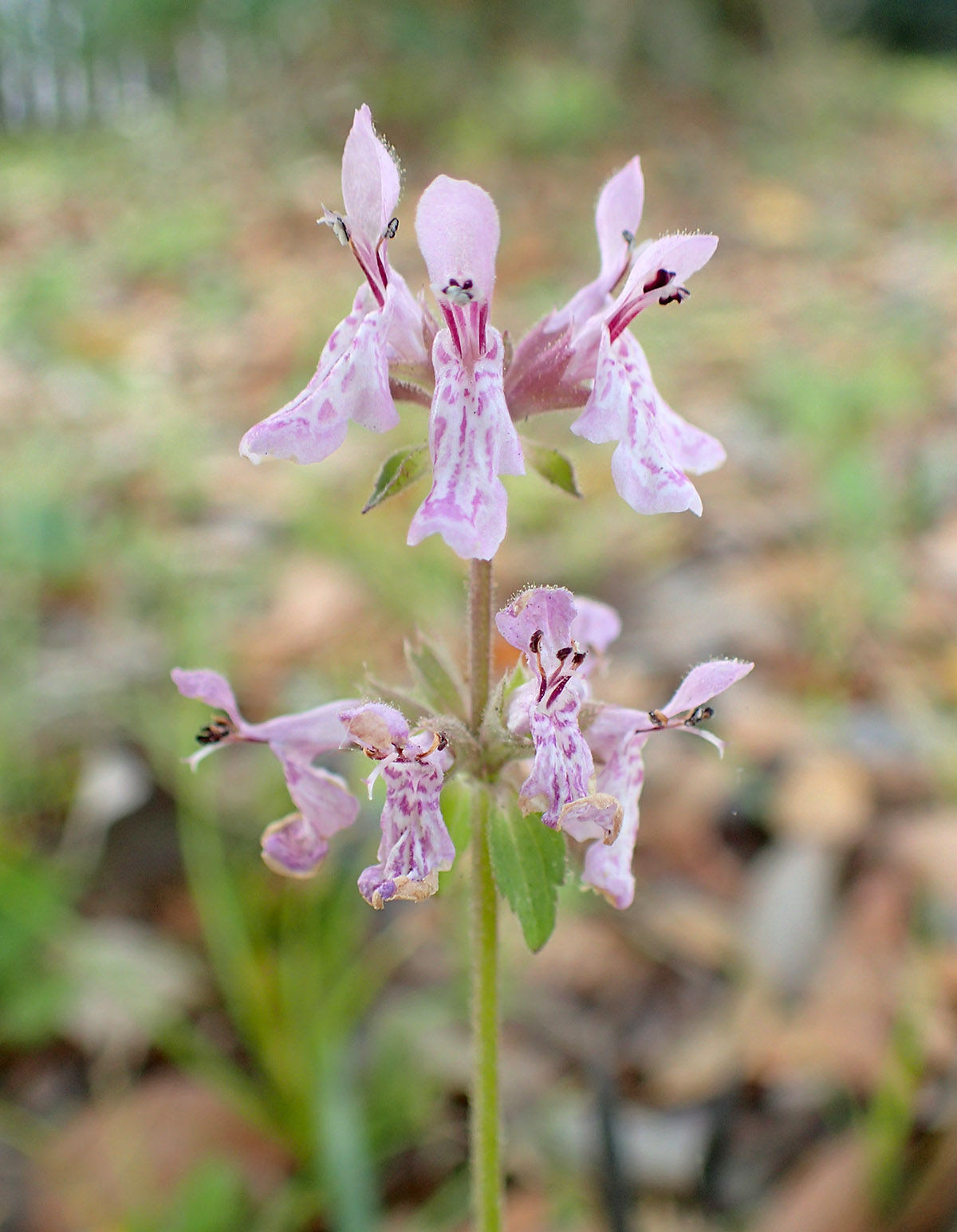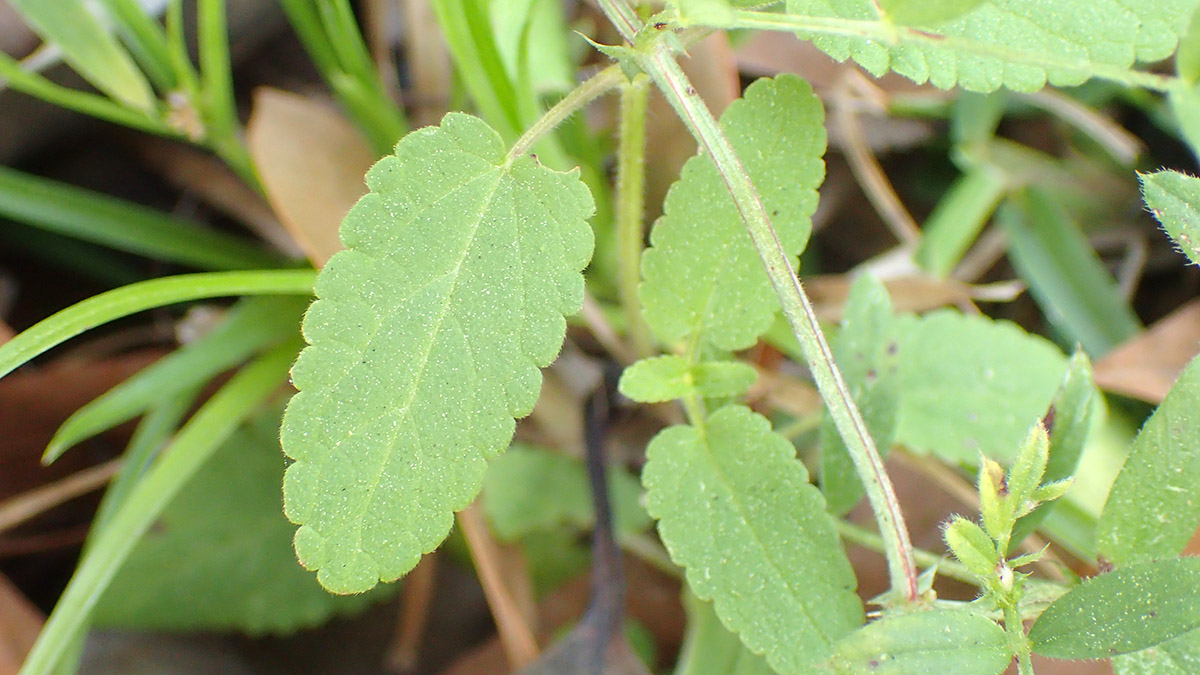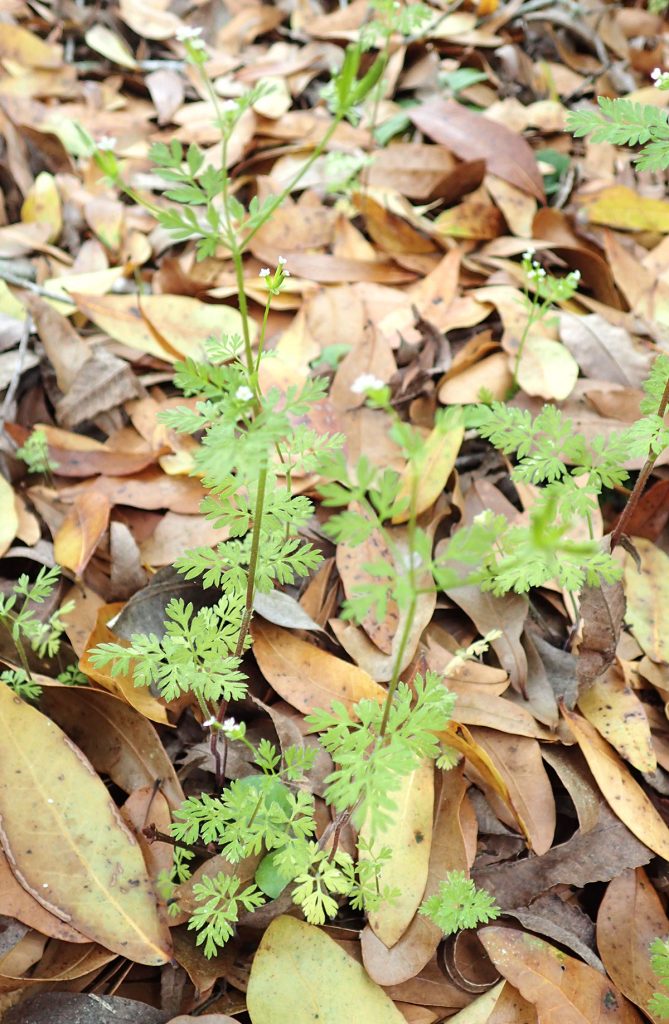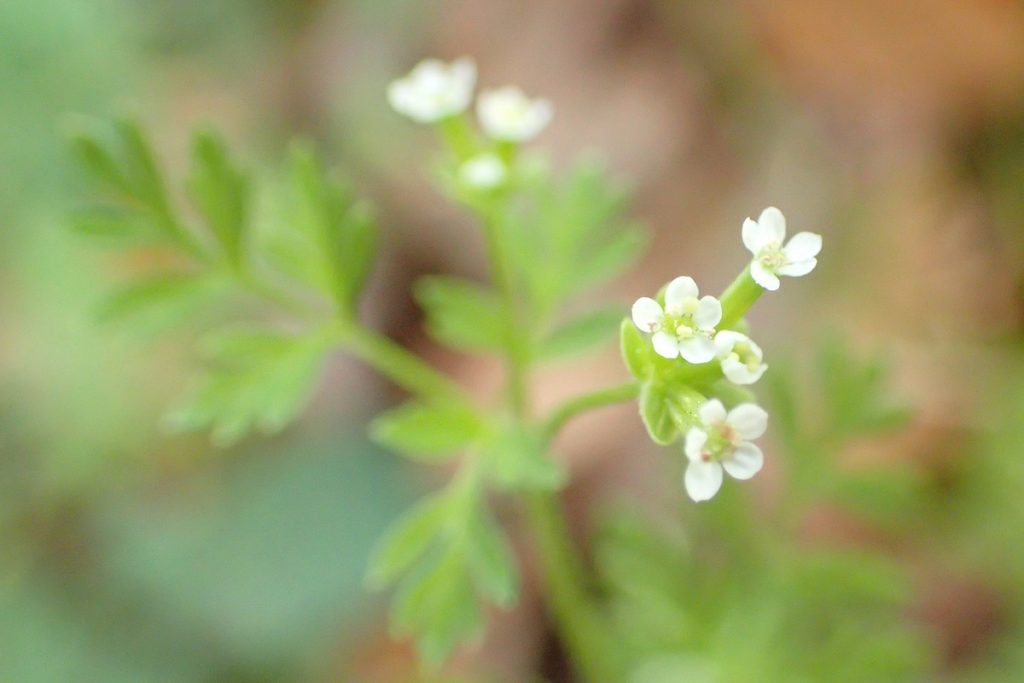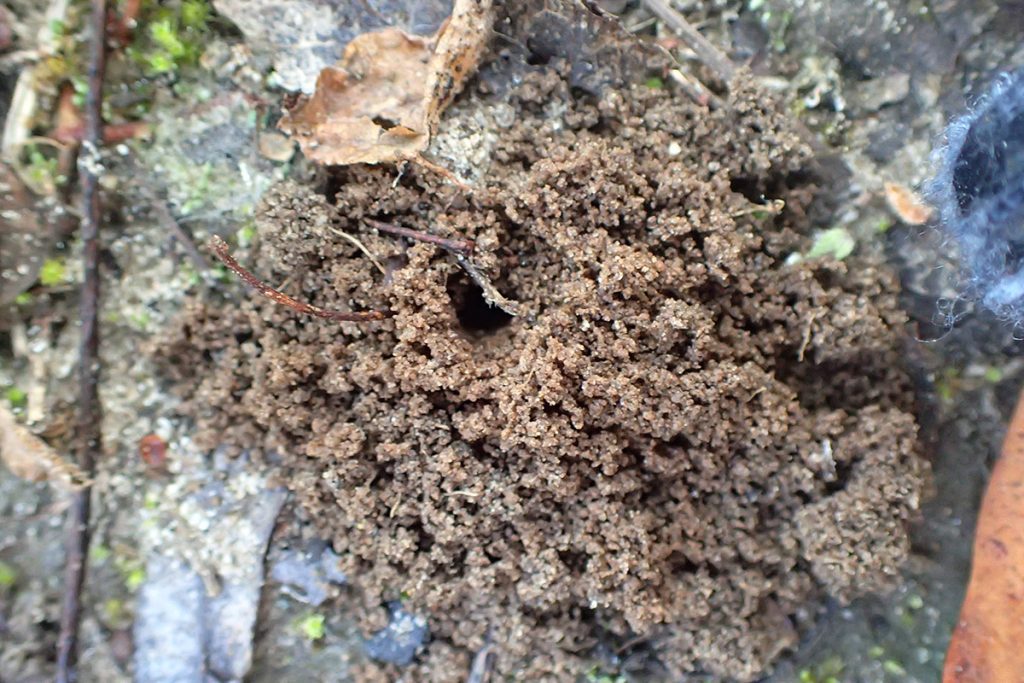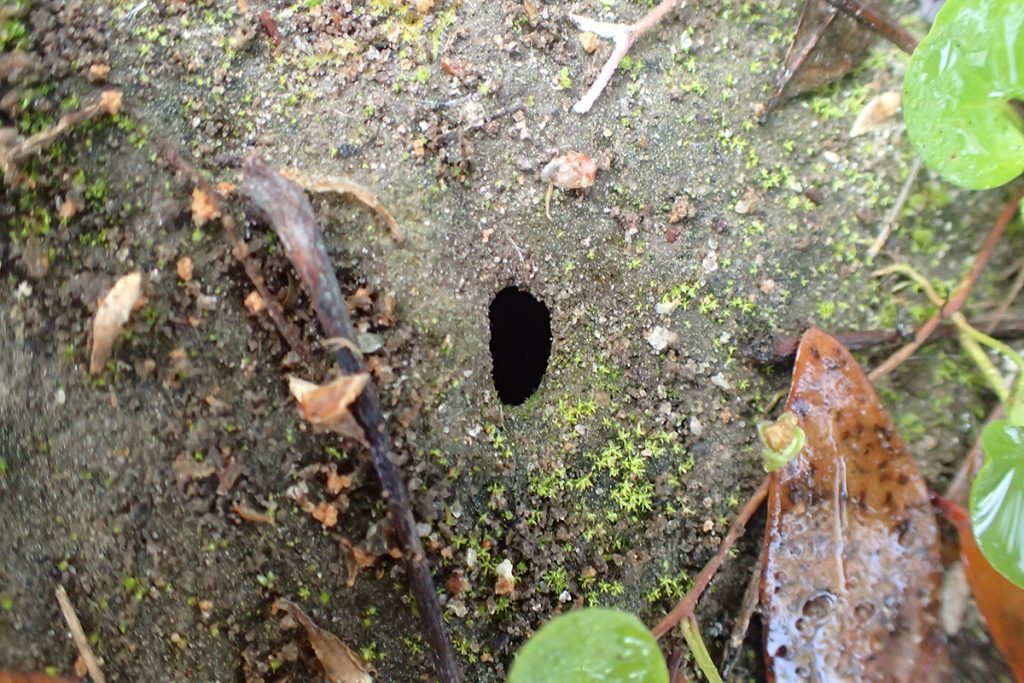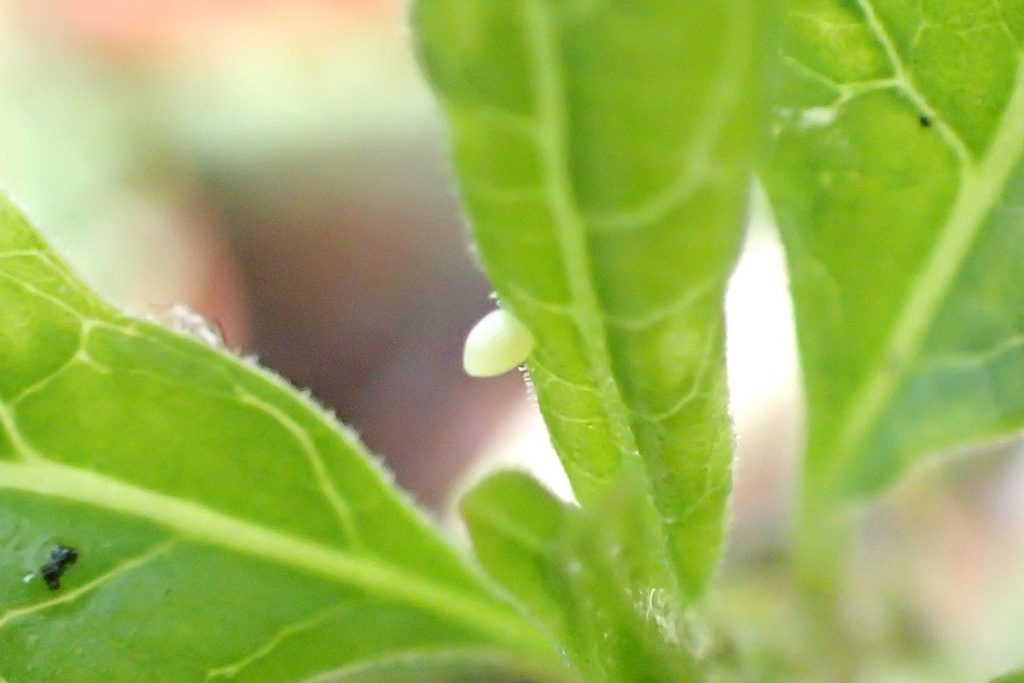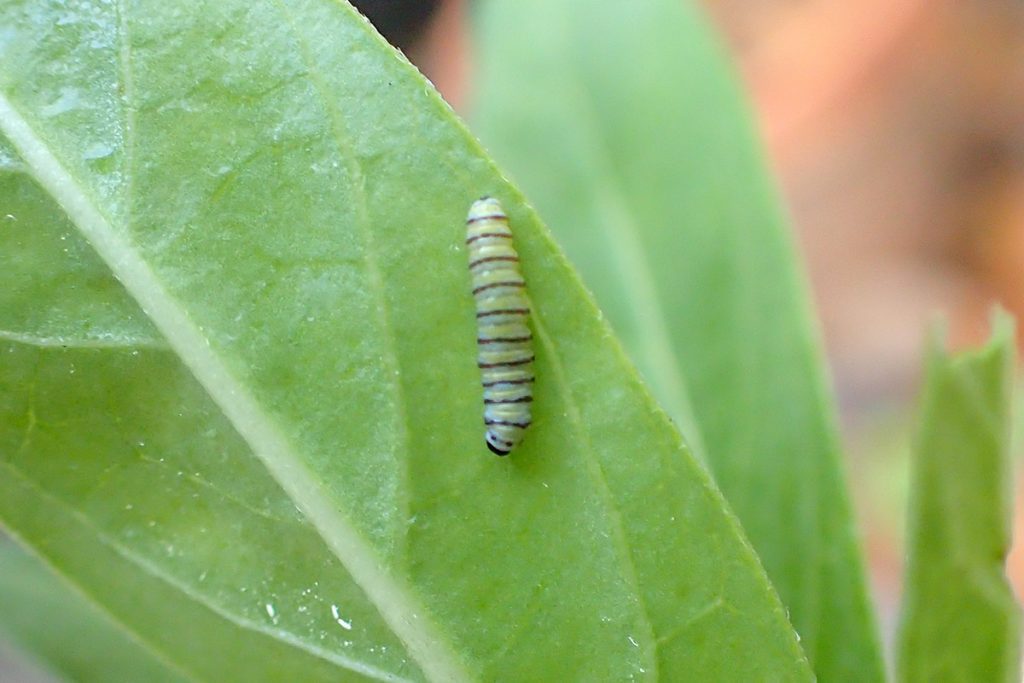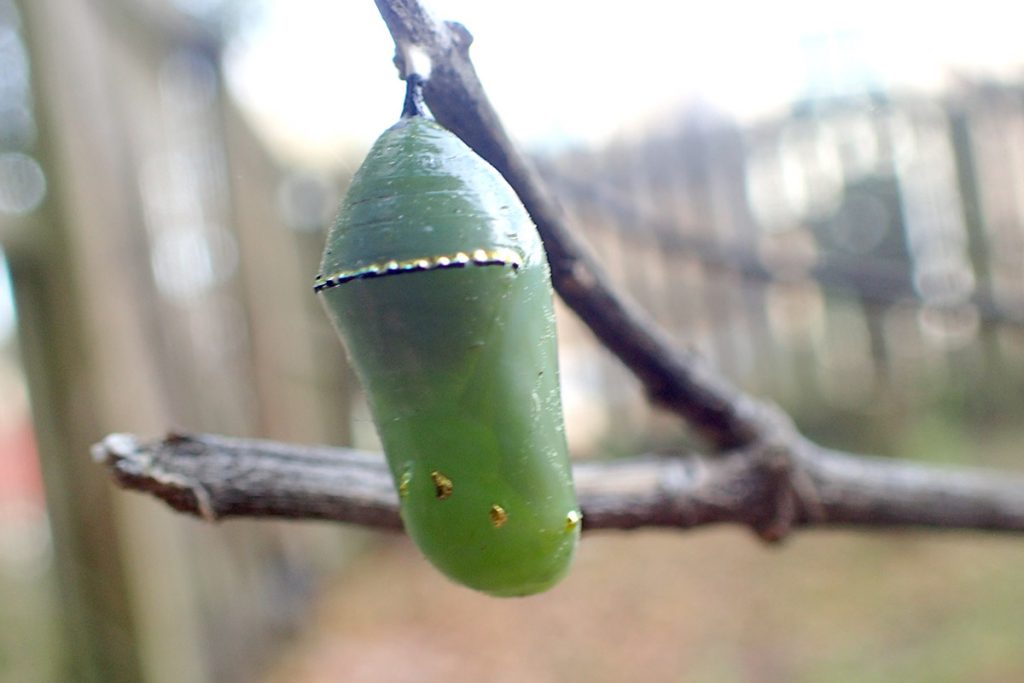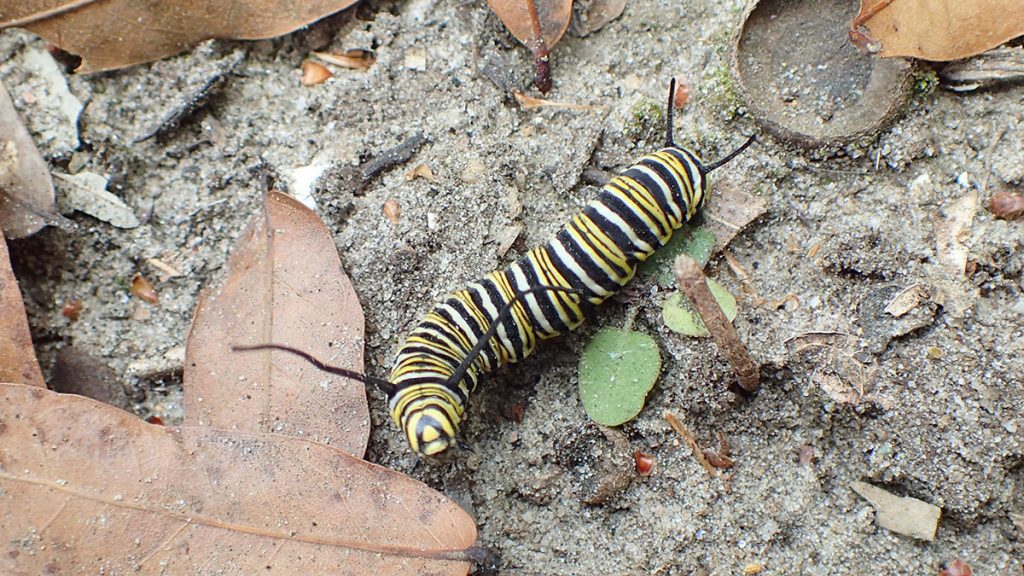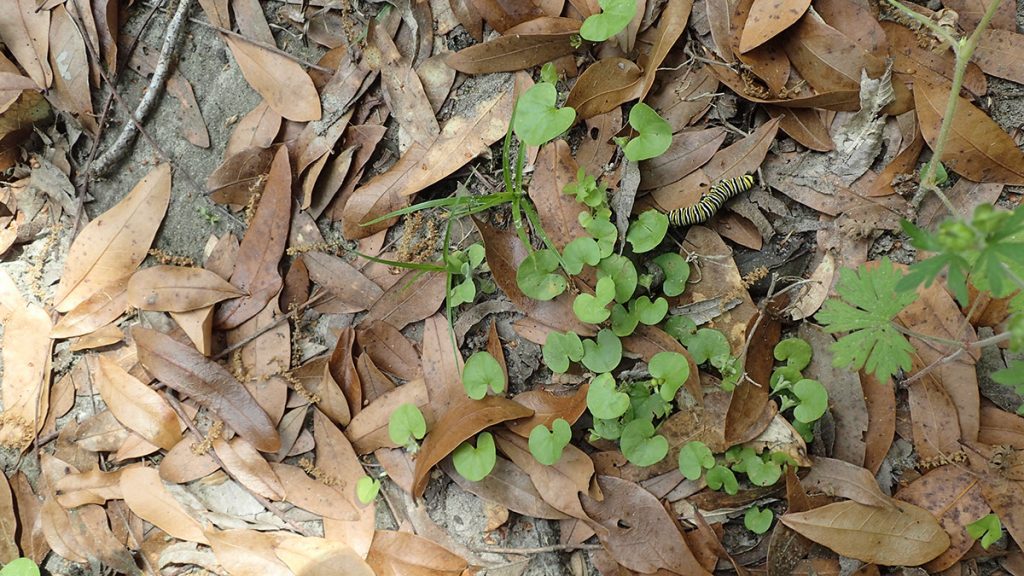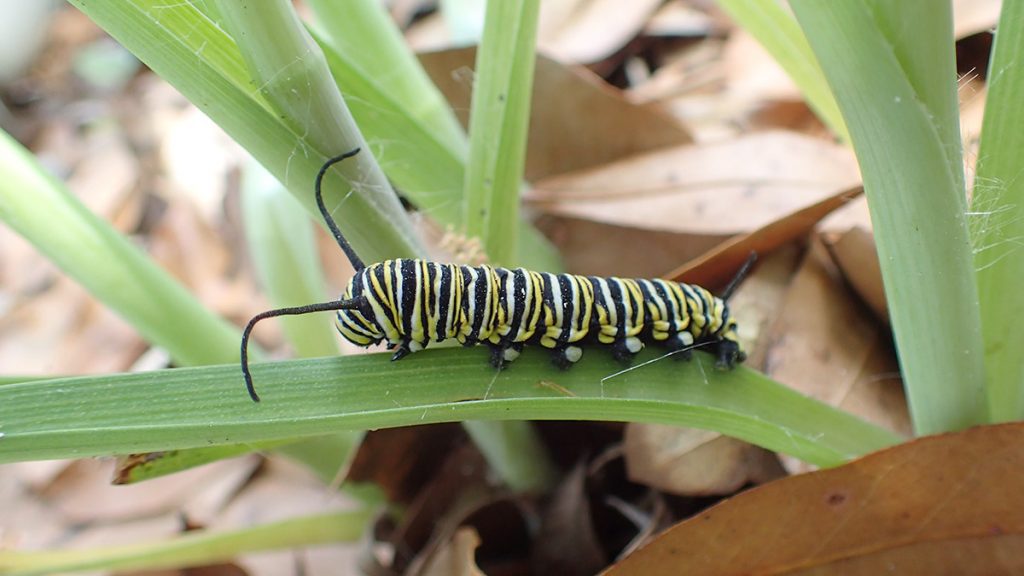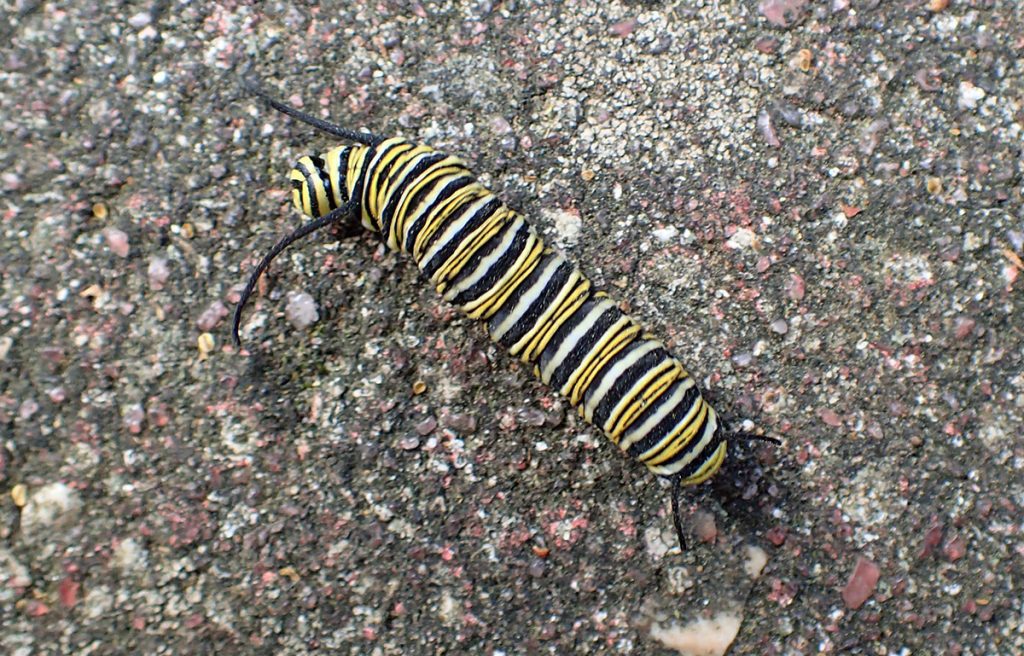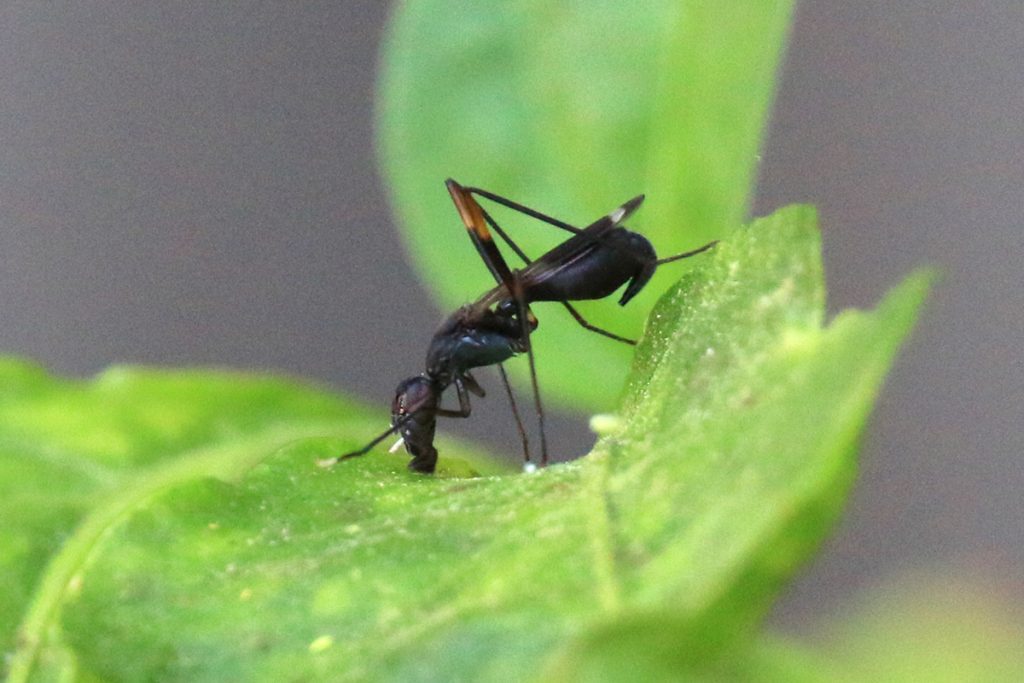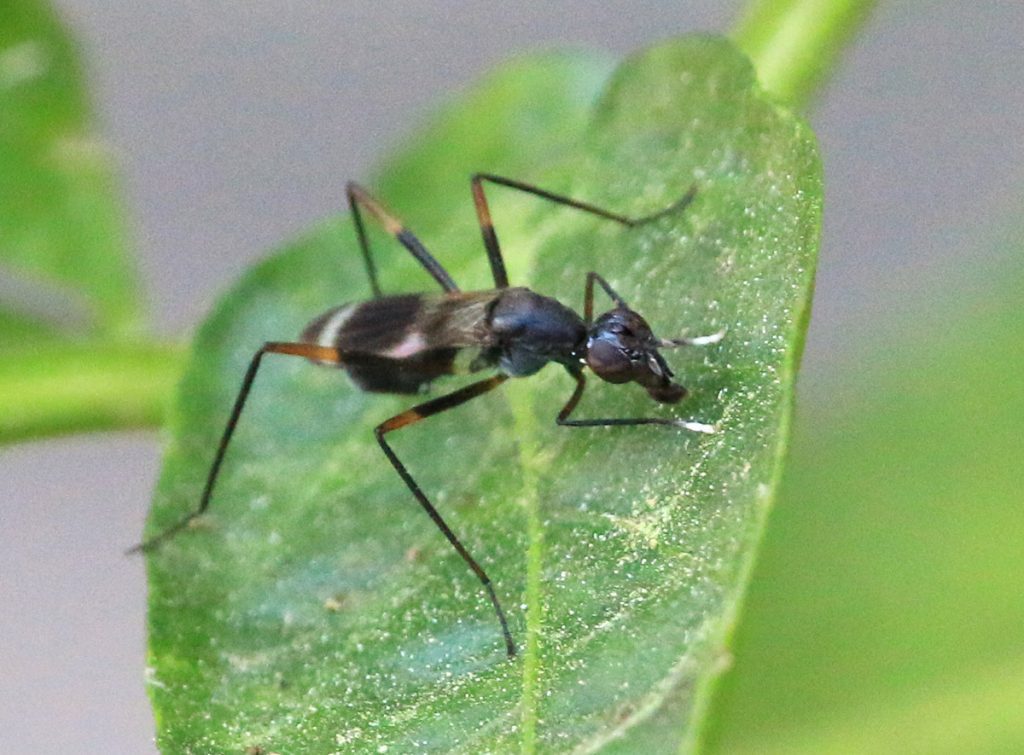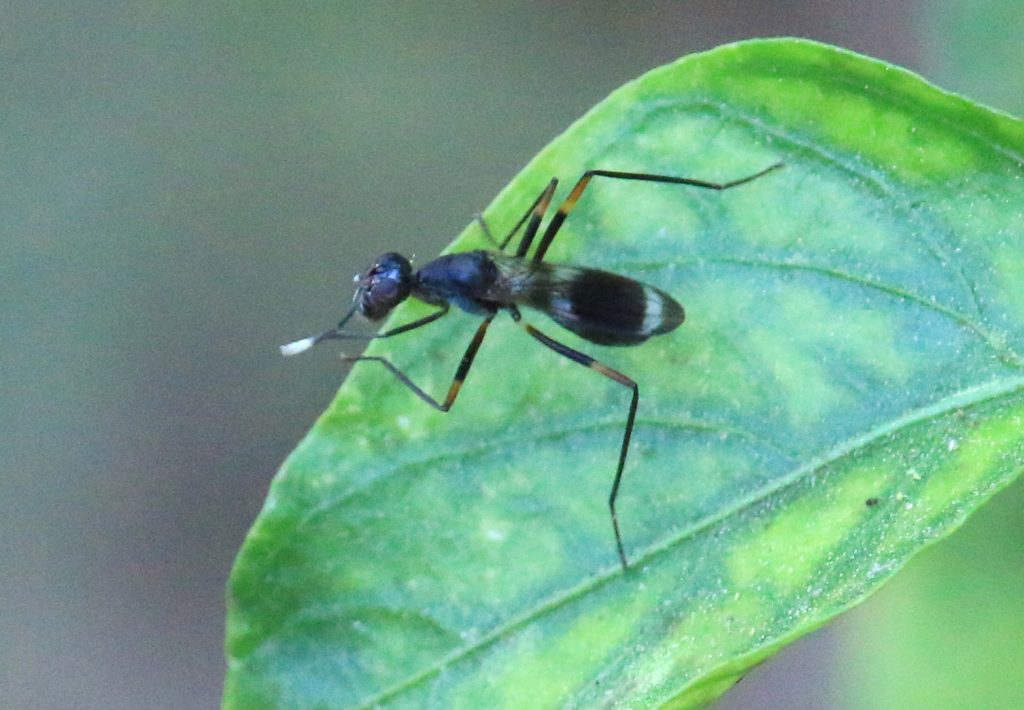This is the first Backyard Blog I’ve written since having to work from home. Being home all day, I can keep a much closer eye on the critters crawling and flying in the yard. Any ten minute break I take from my work, I’m out with a camera. And, since I know we’re all mostly stuck at home now, I hope we’re all able to enjoy a little more garden time.
For those of you new to this section of the WFSU Ecology Blog, I take photos of every living thing I find in my yard. I had been doing this for a while, actually, before I started writing about it. But I started seeing some cool things, and so this section of the blog sprang into life in 2018.
I identify as many plants and animals as I can, usually with the iNaturalist app. I also look up a lot and read more about a lot of what I find. Over time, you start to see how all of these living things behave as the seasons pass. And you also start to see relationships between each of the individual players. Even in a small yard like mine, there are a surprising number of stories to be told.
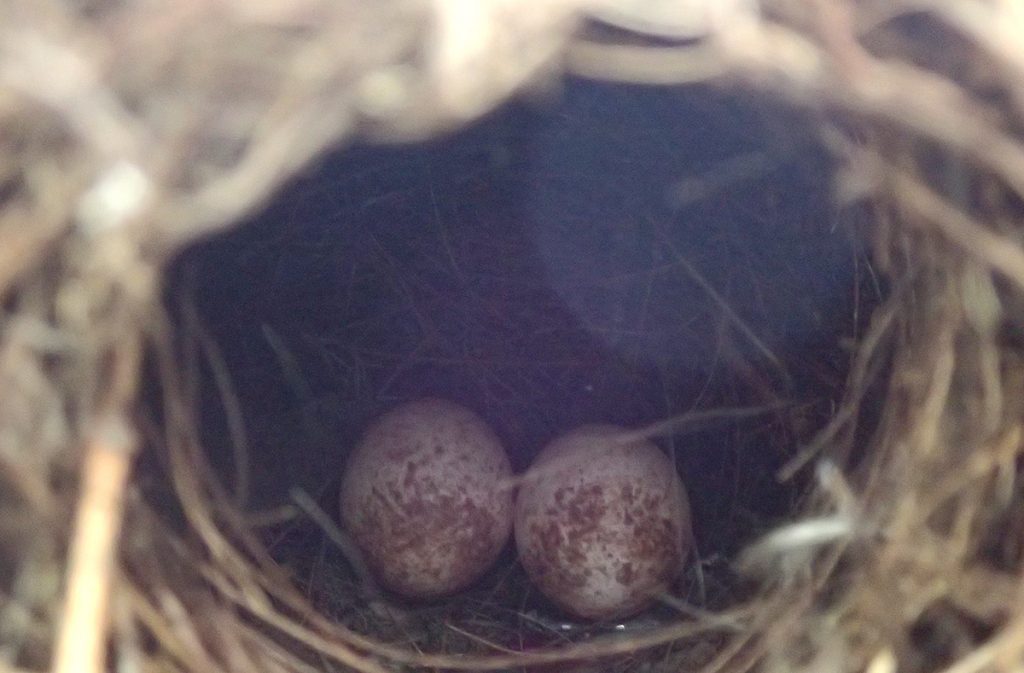
Let’s start with something cute: Carolina Wren chicks
I was watering a hanging fern on Leap Year day when a bird flew out. This has become common in my yard, and so I took a peek and found a nest with two eggs. It kills me that last year, wrens built a nest in another hanging pot right across the porch. But they made this new one anyway. It’s a little disruptive to the plant, and I had read that they reuse nests. But no.
Anyhow, here we had a small clutch of Carolina wren eggs.
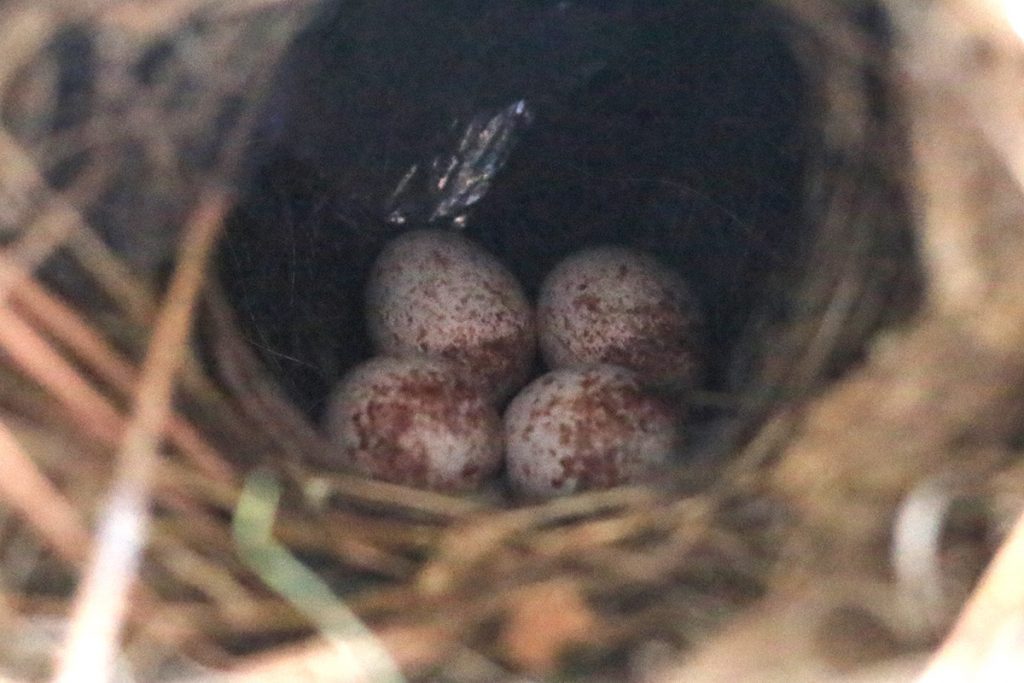
I didn’t look back for another two weeks, and saw that there were two more. Had I spooked the mom in the middle of laying eggs? Or did these come a little later? Interesting.
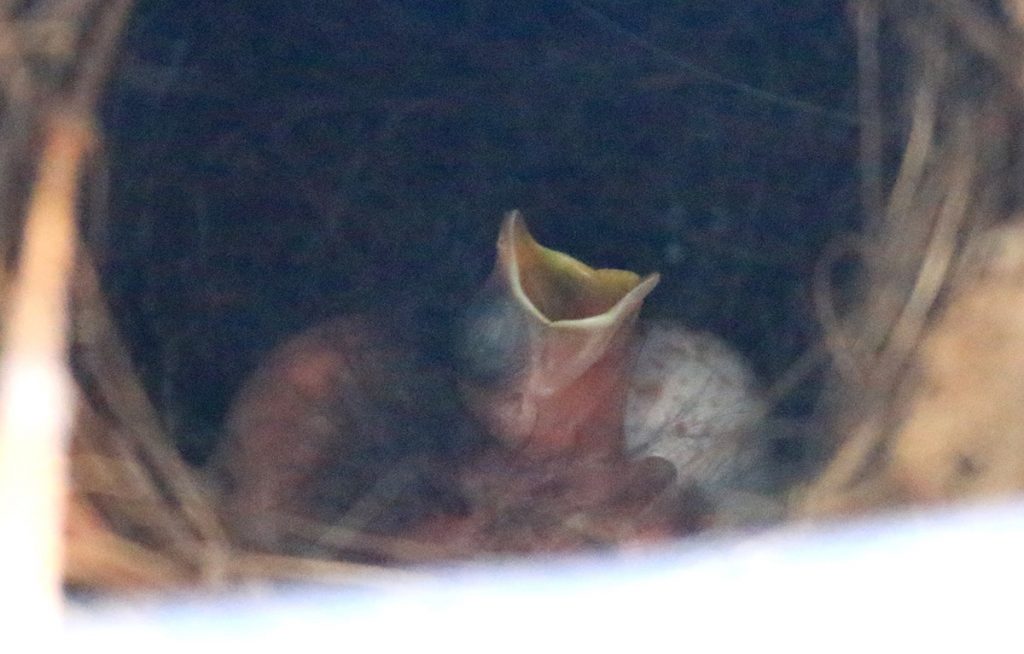
A couple of days later, I saw mom fly off and I took a quick peek with my camera. I think this hatchling thought the camera was there to feed it. Notice the unhatched egg behind it. I couldn’t find anything about wrens staggering their clutches, though I know wood storks will lay one egg after the first one or two, as sort of an insurance policy if disaster claims the first hatchlings. Carolina wrens in Florida can have up to three broods, which increases the number of offspring that survive whatever it is a wren has to survive.
When I started Backyard Blogging in 2018, I was looking entirely at insects, spiders, and other creepy crawlies. Even after expanding to all animals, honestly, it still ends up being mostly about insects. These wrens’ parents are scouring my yard for baby food, which is mostly caterpillars.
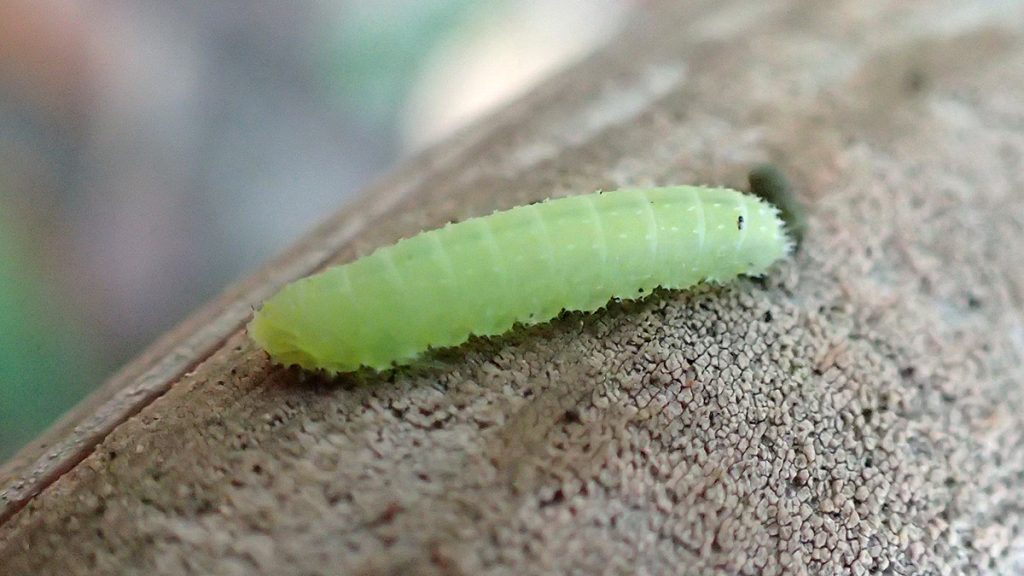
And caterpillars eat plants; mostly, native plants. A lot of those native plants, well, a lot of us call them weeds.
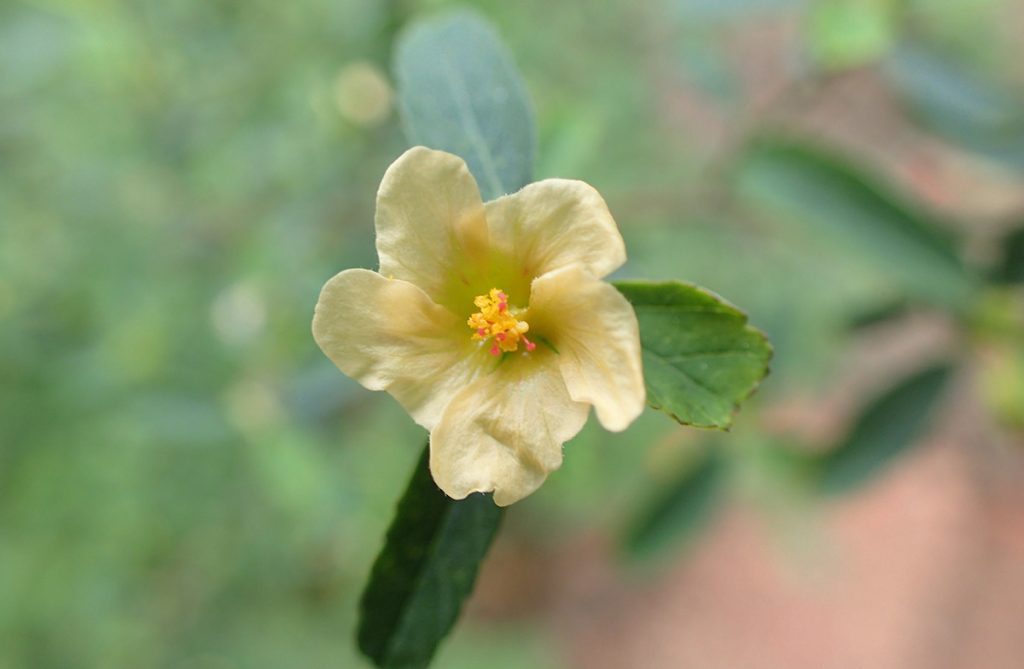
Native “weeds” in the yard
The flower above is about a centimeter across, but it’s on a big woody bush that I didn’t plant. It’s a fanpetal. They’re a weed in that I didn’t invite them into the yard. And they can take up space and crowd out other plants, so I do have to manage where they grow.
But small bees like the flowers. And it’s a larval food for checkered-skipper butterflies; in fact, I photographed what looked like an egg laying last August. So I do leave some space for fanpetals.
Carolina crane’s-bill (Geranium carolinianum)
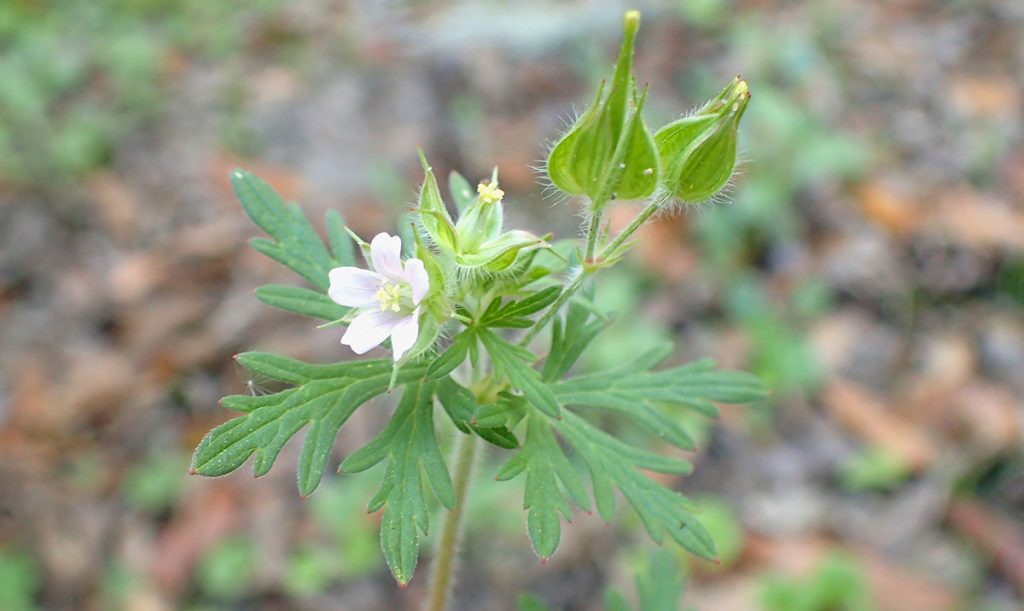
A lot of other weeds are smaller, and don’t flower right away. This native geranium has distinctive leaves, so I know it and I let it grow. I haven’t seen many pollinators on its tiny flowers, but I was surprised the other day to see what did like to eat it:
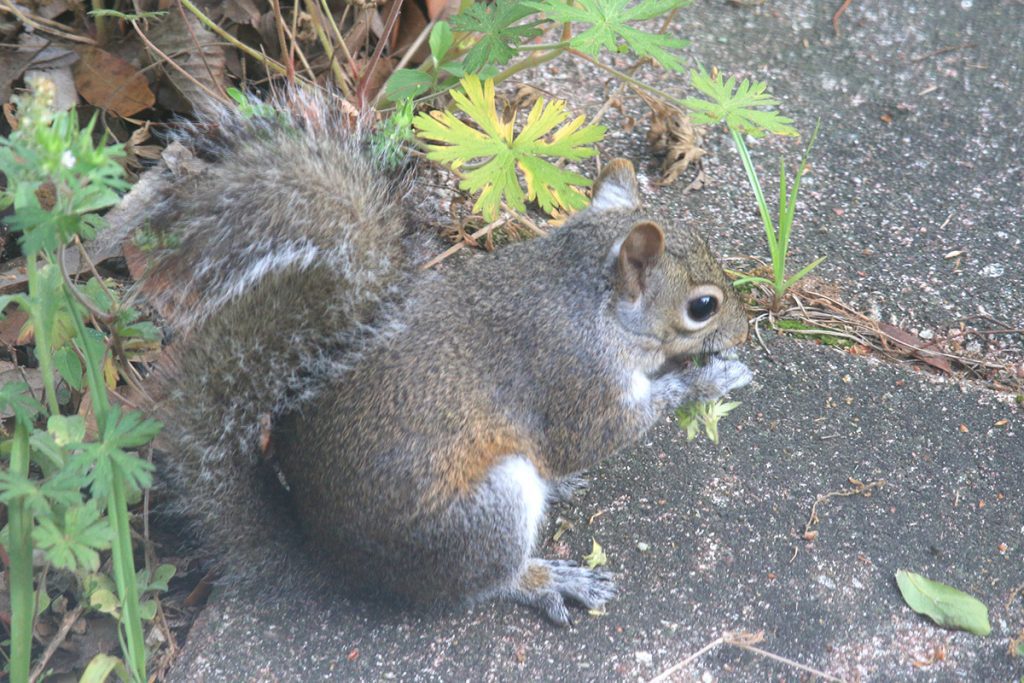
I saw the scene above from out my window. It grabbed a thick part of the plant with a lot of “crane’s bills,” the seed pods.
Clasping venus’s looking glass (Triodanis perfoliata)
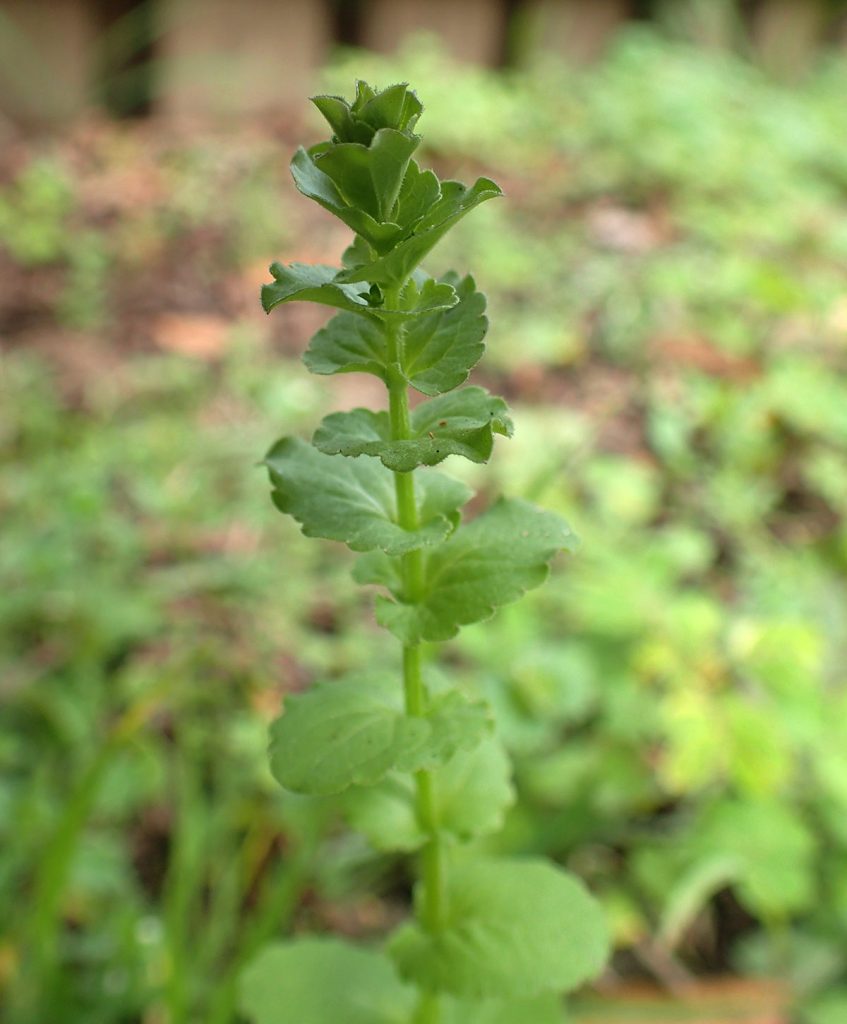
Here’s another one whose leaves grow in a distinctive way. I took this photo on Februry 13, when I first noticed them in the yard. I learned about it last year after I started iNaturalizing every thing in my yard.

The flower of the clasping venus’s looking glass (Triodanis perfoliata). 
Clasping venus’s looking glass (Triodanis perfoliata) flowers. 
Clasping venus’s looking glass (Triodanis perfoliata) flowers.
These are from March 22, when I first noticed their flowers.
It’s a very small flower, which you can’t tell because there’s nothing for scale. I already knew what this was, so I didn’t take these exactly as I would for iNaturalist. For wildflowers in the yard, I take a flower closeup. Next is a closeup of leaves, because there are several species with nearly identical flowers, but whose leaves are different. And then I take one of the whole plant, sometimes with my finger or hand in it for scale. If you do this with your iNaturalist pics, you’ll give the experts on there a better chance of identifying than if you took a single flower pic.
Crowpoison, aka false garlic (Nothoscordum bivalve)
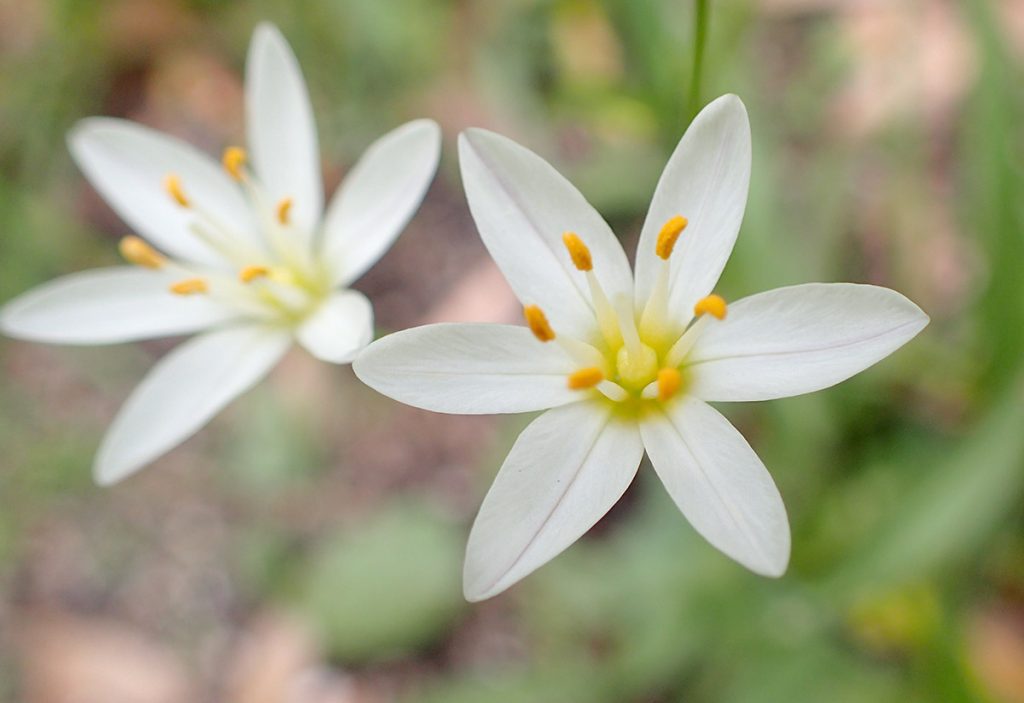
Another very small flower, but pretty when you zoom in. Here is a shot which gives you better scale:
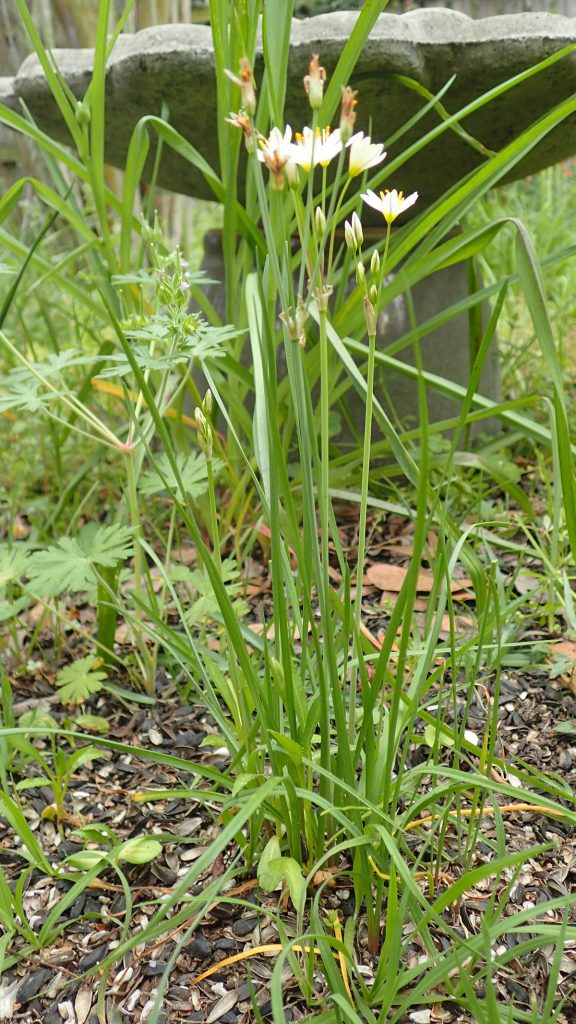
There’s a lot about this plant that we don’t see if we don’t include a second or third photograph showing leaves and stems. And I have seen pollinators on these flowers:
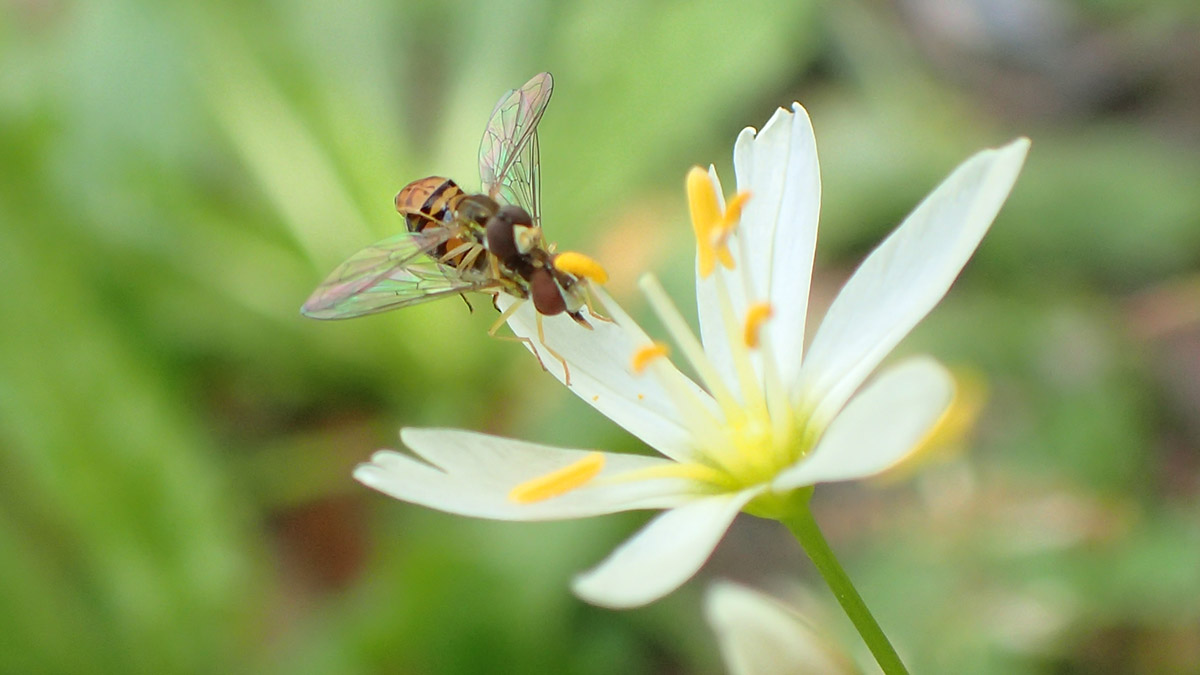
I hadn’t noticed that there were two of them until I looked at the photo later. We’ll have much more on hoverflies later; they’re one of my favorite pollinators.
Florida hedgenettle (Stachys floridana)
A few of these are growing in the shadow of our laurel oak. Another tiny plant. I didn’t notice how pretty the flowers were until I got up close with the macro.
Hairyfruit chervil (Chaerophyllum tainturieri)
The lacy leaves are typical of plants in the carrot family. This is named for the French herb chervil (also a carrot relative), likely for the similar looking leaves. That’s my best guess for the plant so far; I’ve never had anyone verify it on iNaturalist. Sometimes the best you can do is compare a plant to several other similar looking species.
If you’re ever frustrated by lack of identifications on your observation, look at them on a computer and hit the compare button next to the species name. You can compare your guess with other photos of the species, by genus or other higher classification, and you can filter by location. The default is to show you species that have been observed in your area (usually county). But what if you’re the first to log it on the app in Leon County? Then you can remove that filter, which let’s you see more species, but often ones from nowhere near you. You have to pay attention to that.
The chervil is plentiful beneath our laurel oak, on the east side. The west side under the oak has the Florida hedgenettle. Last year, I remember that the chervil didn’t last past mid-spring. I’m not sure if that’s a seasonal thing, or if it was zapped by drought. I lost a lot of “weeds,” which I don’t water, then.
Ohio spiderwort, aka bluejacket (Tradescantia ohiensis)
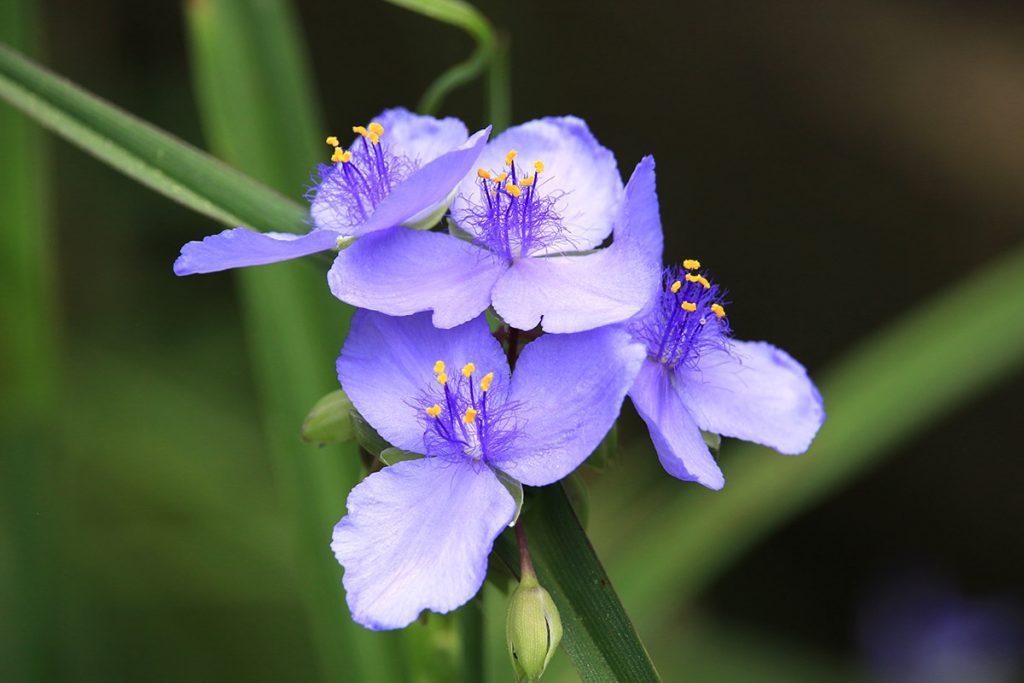
Not everyone loves this plant. It’s native, edible, and pollinators love it. But it grows everywhere, and it’s tall. So it doesn’t fit everyone’s aesthetic. We have a small yard, but we easily have over 100 of these growing.
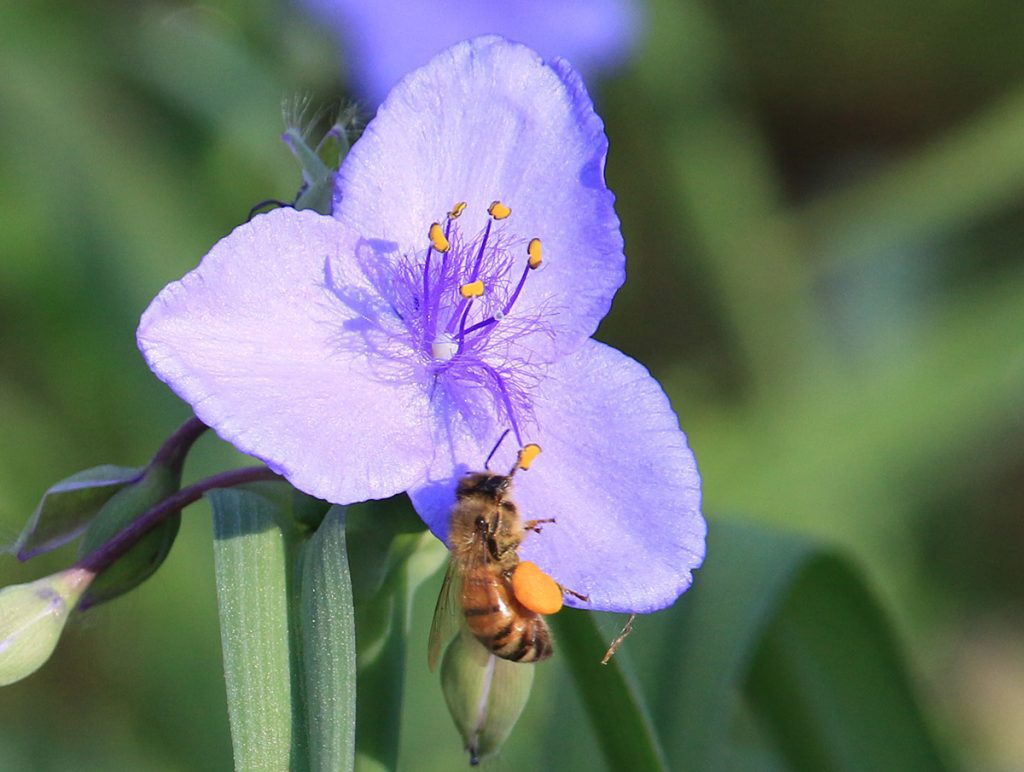
We have two or three honeybees who make the rounds on these every morning. The flowers close in the afternoon. Look at the pollen sack on the bee’s leg, and how the color matches the color of the pollen in the flowers stamens.
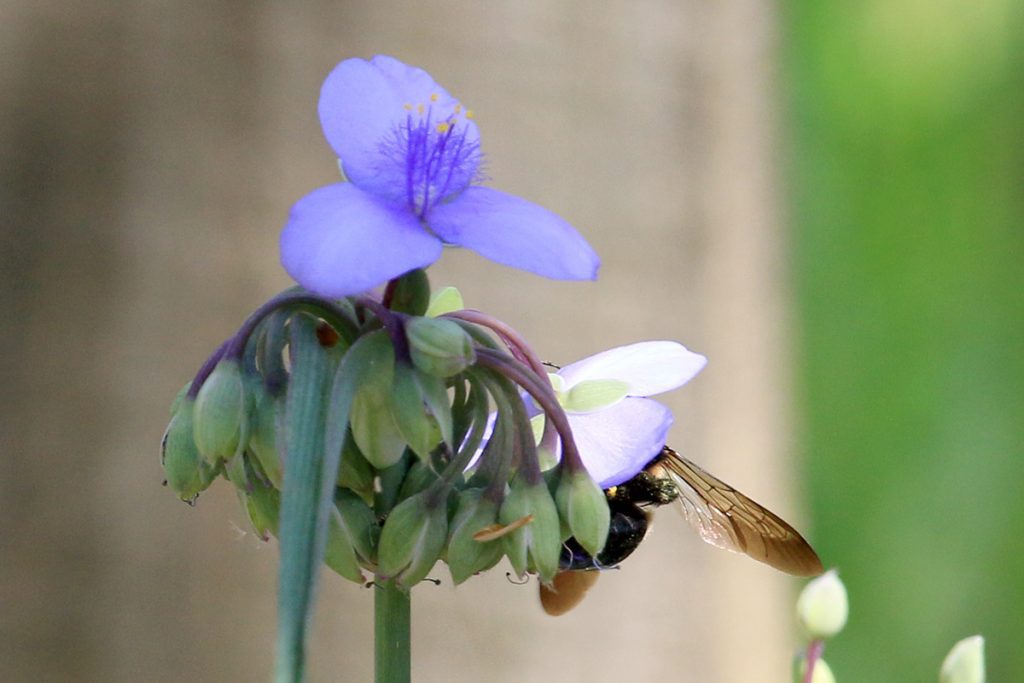
This carpenter bee has been flying around our yard, and I see where it likely made its home in a fencepost. This is the only time I’ve caught it on a flower. It wasn’t there long, so I didn’t have an opportunity to get in place for a better angle. Anyhow, here’s its home:
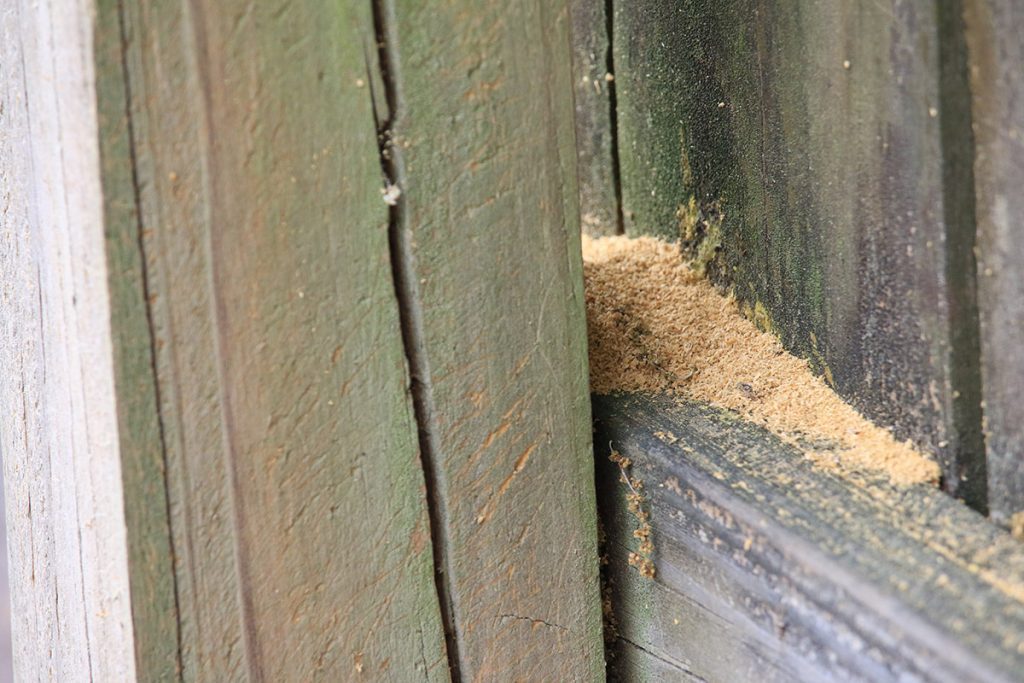
I’ve also see a four-toothed mason wasp using the same post, a little lower down. I had previously seen those wasps nesting on the railing to our back steps. No photos as of yet, though.
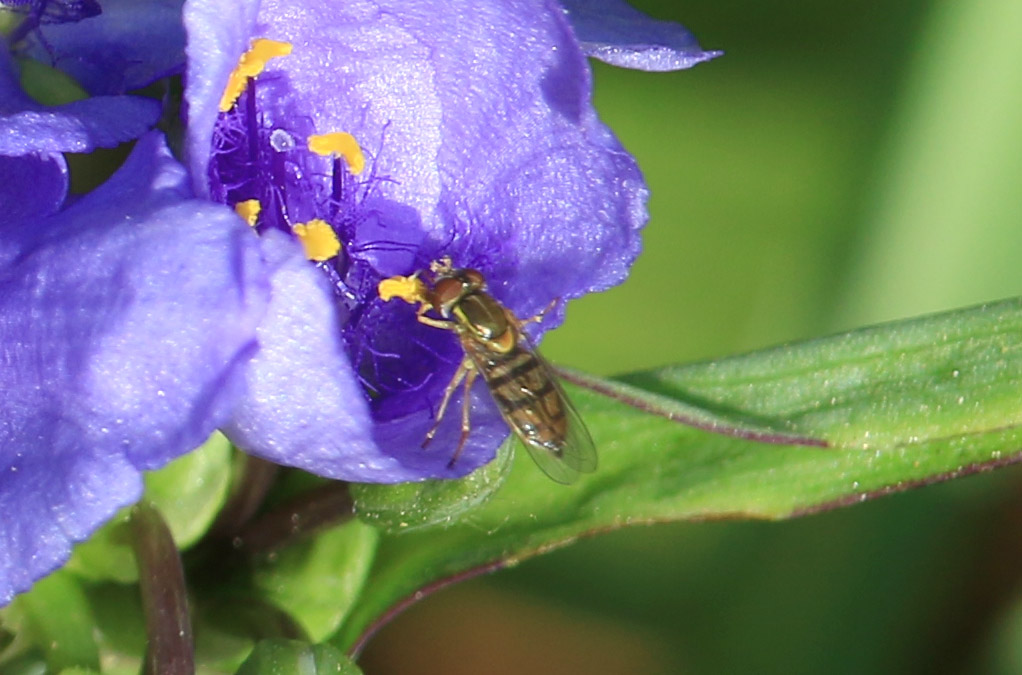
And here’s another quick pic of a hoverfly. There are better ones later on to share on this post, which is what I used to upload to iNaturalist. I think I’ve seen two species so far. I also have some pics of their aphid-eating larvae.
Non-native “weeds” in the yard
Common dandelion (Taraxacum officinale) Sow thistle (genus Sonchus)
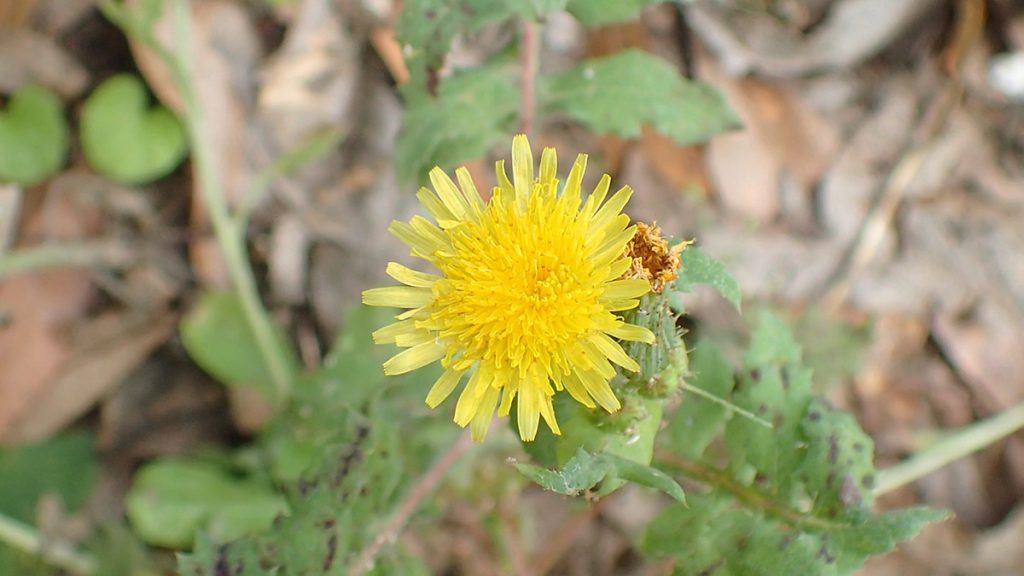
Edit April 2, 2020- I had originally posted this as a common dandelion. It’s a good example of getting hung up on the look of the flower, and the fact that I had iNaturalized common dandelions in the yard. But let’d take a closer look at the leaves.
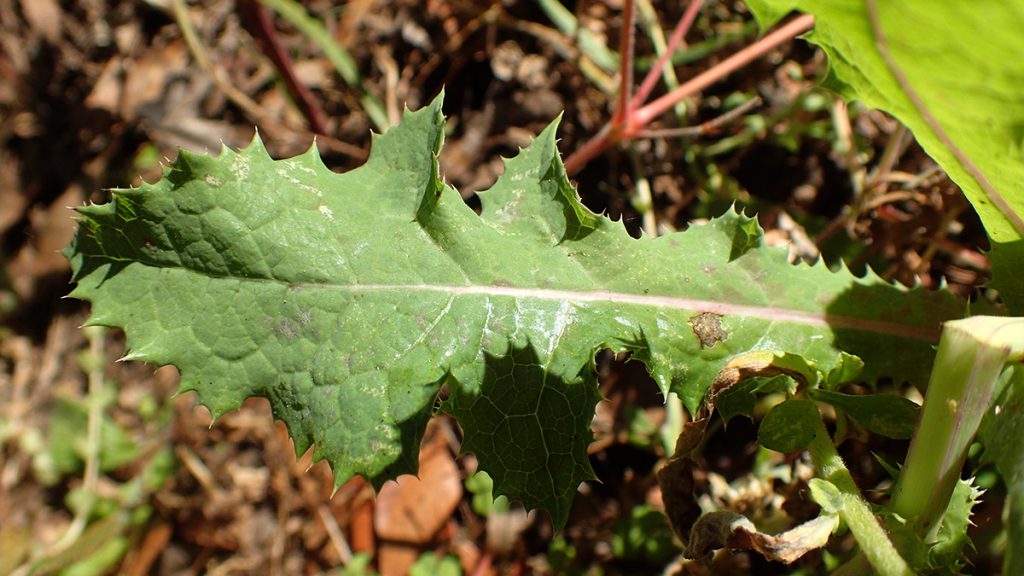
The leaf is the same general shape as a common dandelion, but I should have looked a little closer. The leaf itself is a little rougher. You could throw common dandelion leaves in a salad; these would be hard to eat raw. And then look at the edges:
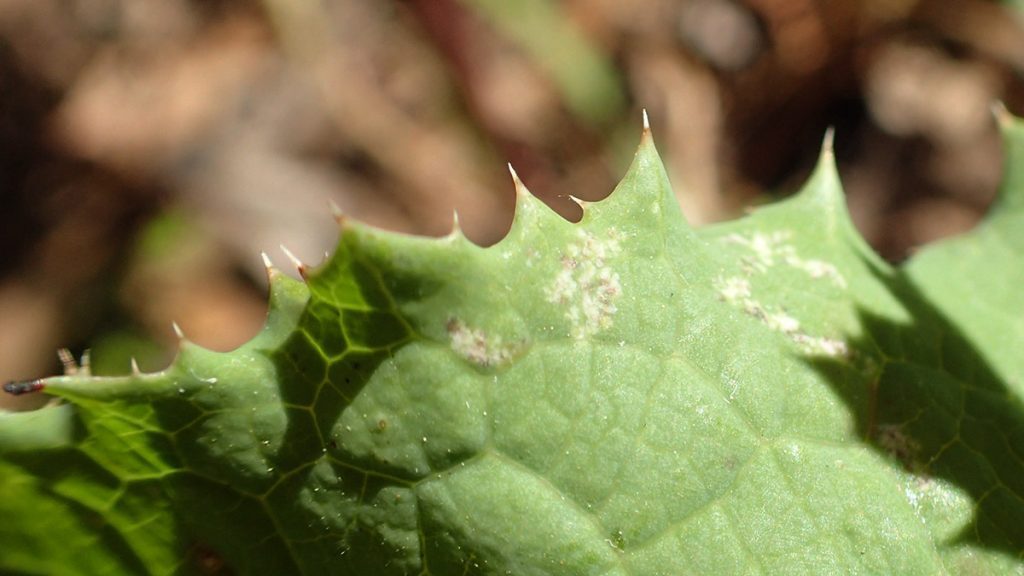
Like other thistle species, it has spiky edged leaves.
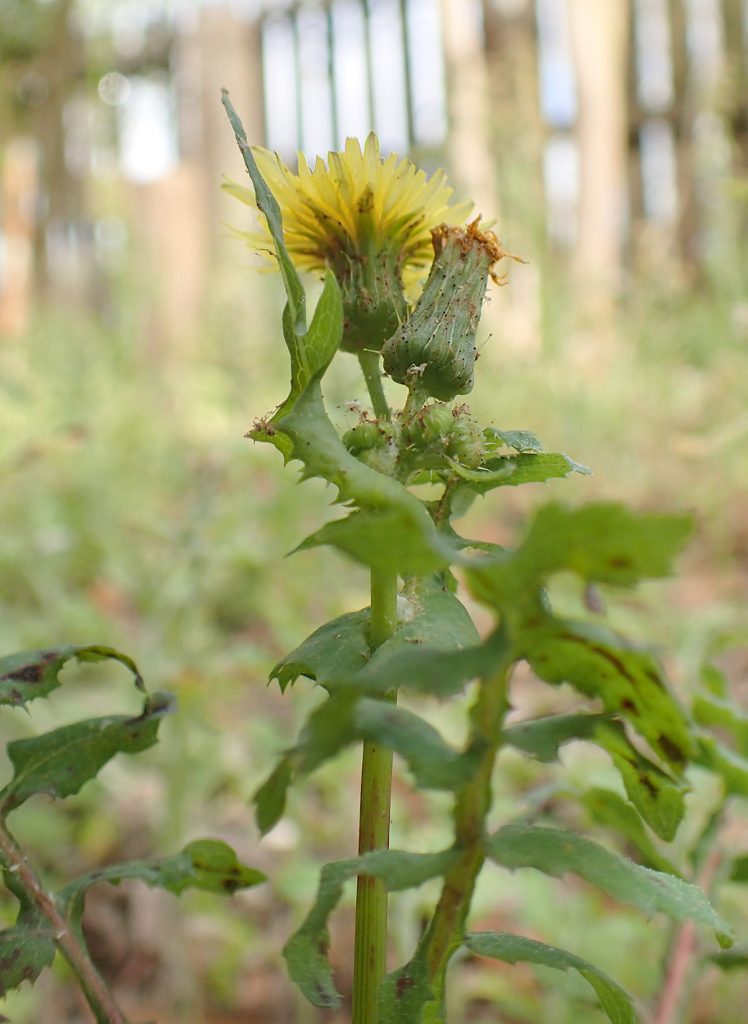
And then, lastly, an iNaturalist user pointed out that dandelions don’t have leaves growing out of the flower stalk. It is a good illustration of how similar these related flower species look, but that we can still ID them by closely looking at the leaves and the flowers, and the plant as a whole.
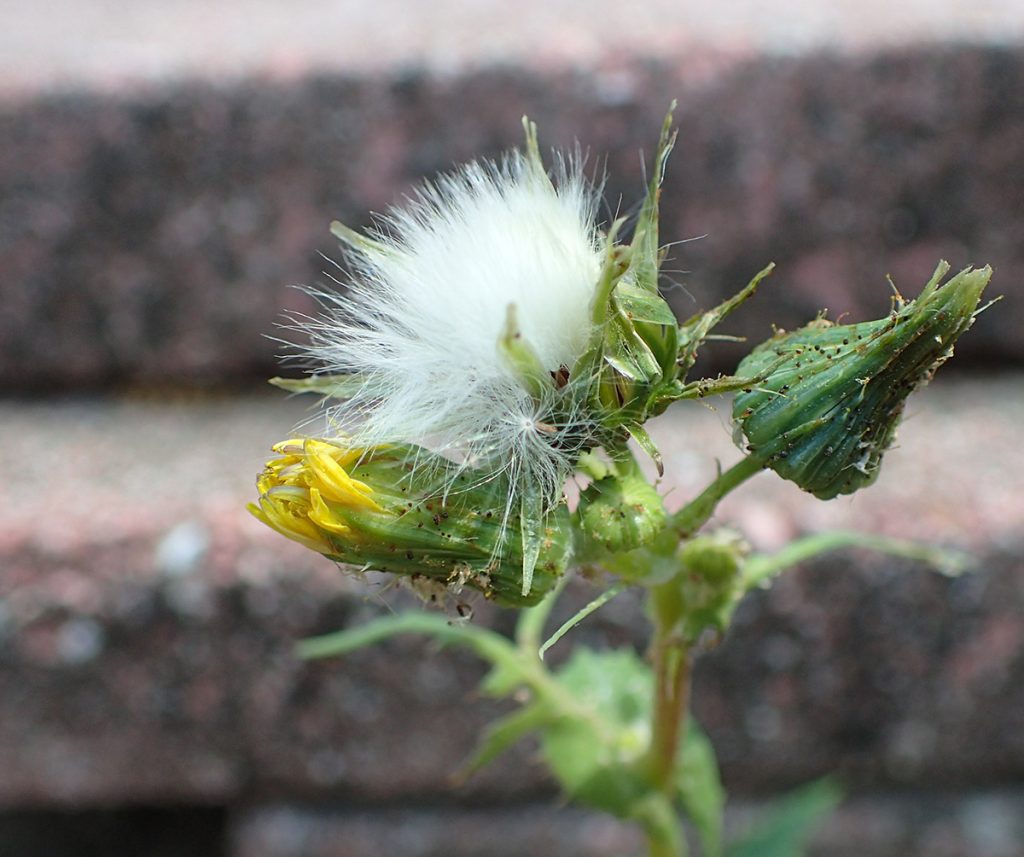
The plant seeds in the same manner as the dandelion, after all, they are related. And like the common dandelion, this is a non-native plant.
Wood-sorrels
We have two species of these low growing wildflowers. Their leaves look kind of like shamrocks, but they’re not clovers.
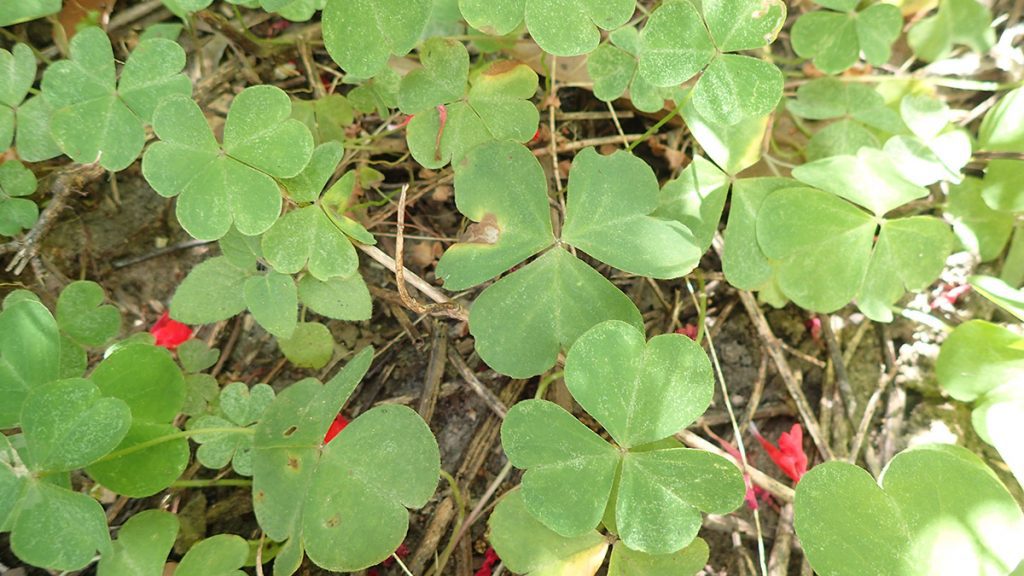
This Oxalis species, pink wood-sorrel, is known as sour flower for its edible leaves. One of many plants growing wild in our yards that you can eat.
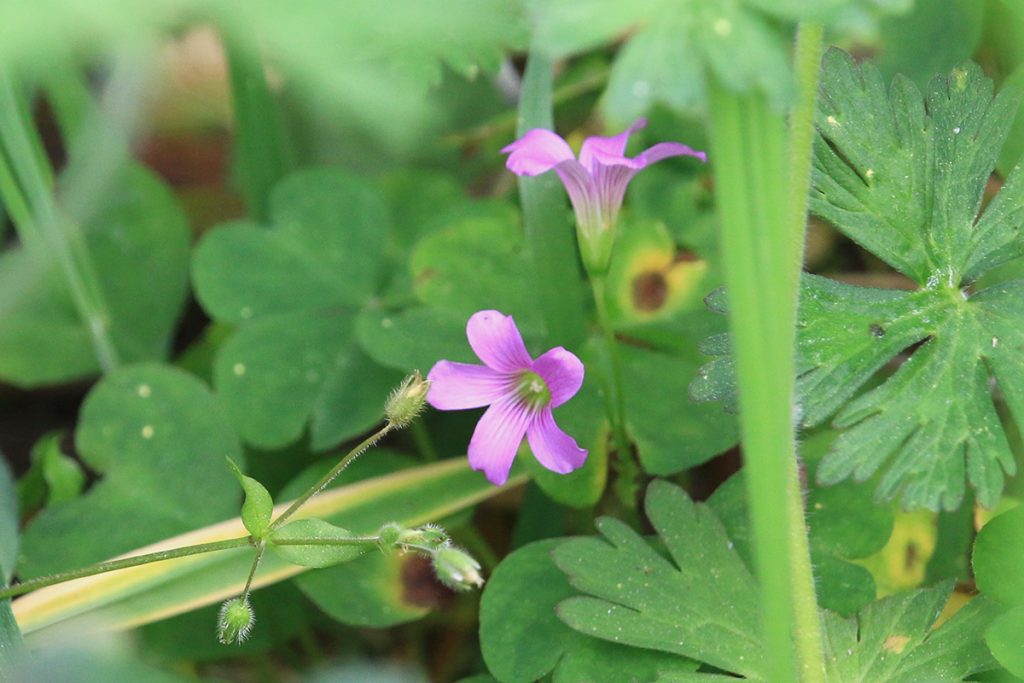
It’s the larger leaved plant of the two Oxalis species growing in the yard.
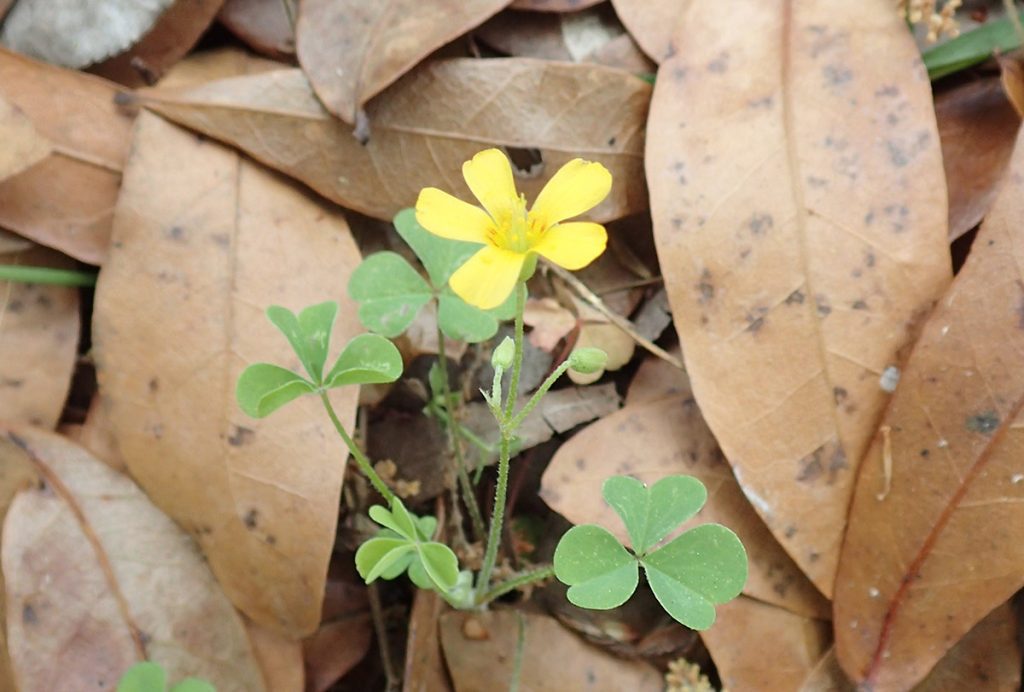
You can see the yellow wood-sorrel flower is proportionately bigger than its leaves, compared with the pink. Here’s a closeup of its flower:
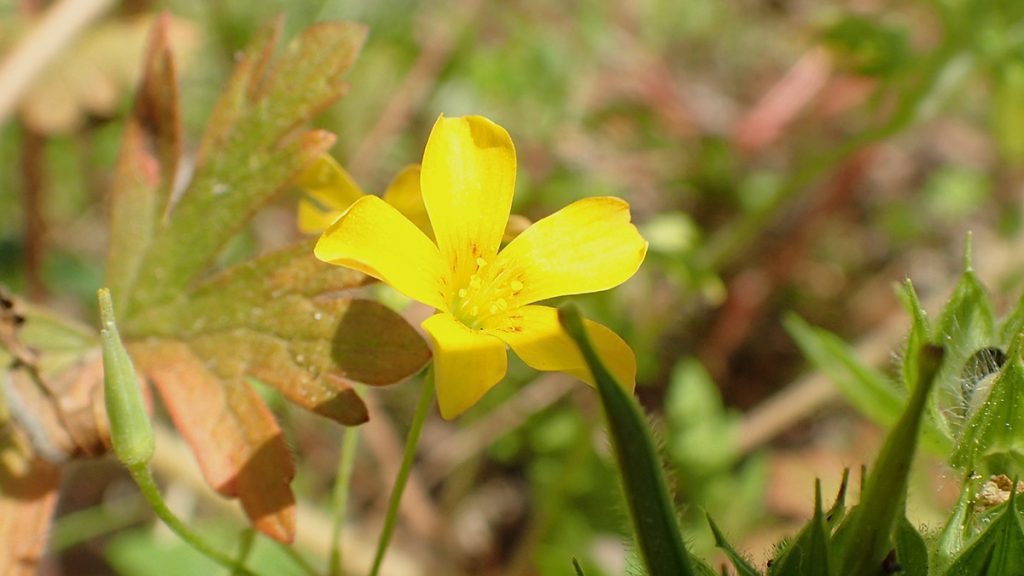
Smooth Cat’s Ear (Hypochaeris glabra)
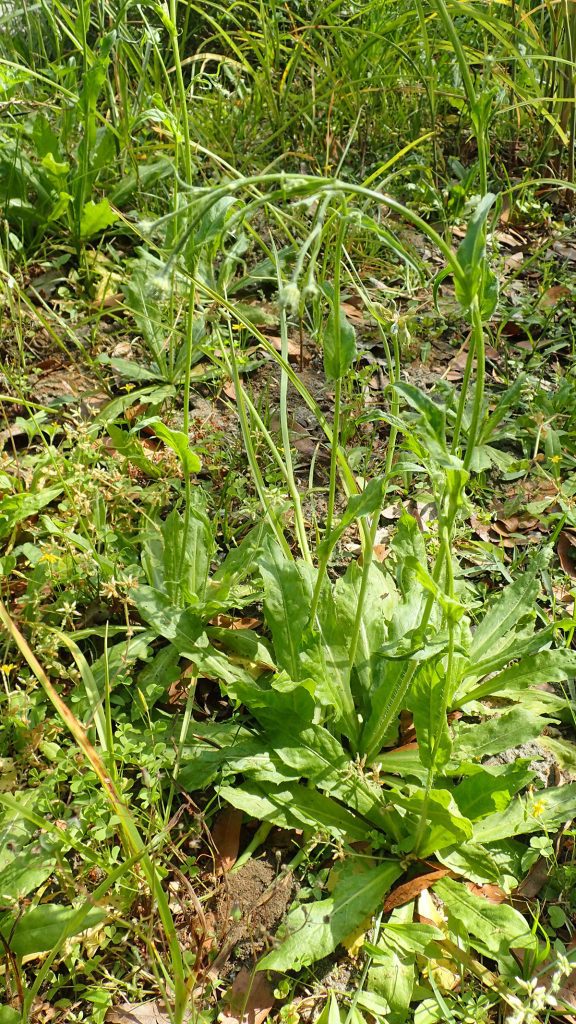
This is a plant I was able to use iNaturalist to identify even before it flowered. I wrote about it in the January 2020 Backyard Blog. It’s a member of the dandelion tribe, many of which have similar flowers but they all have different leaves. This plant’s leaves vary in their appearance. And they’re edible as well.
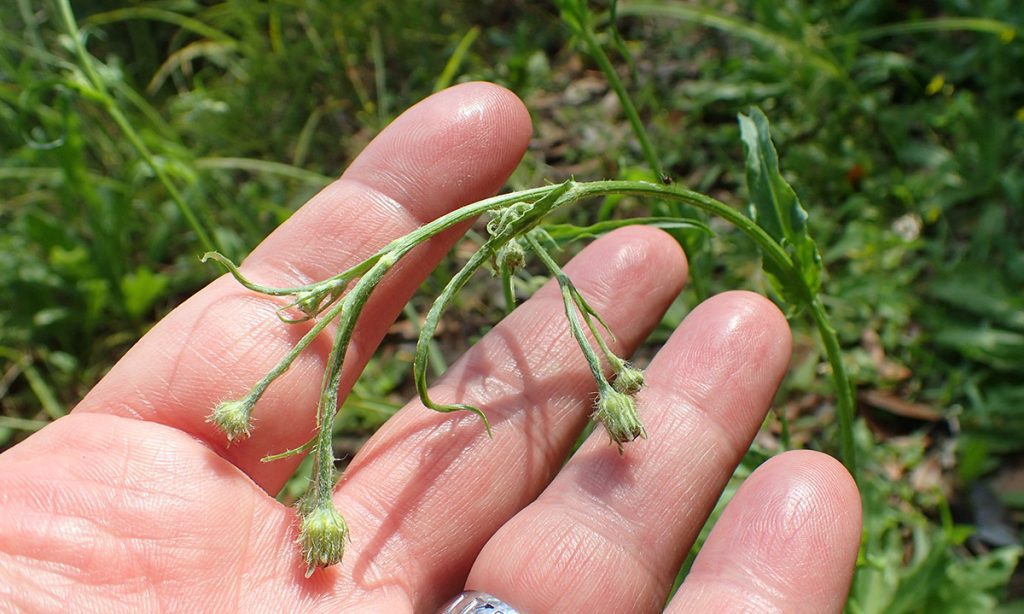
Just this week (March 22-27), I’ve noticed it shoot up a flower bud. So far it hasn’t opened. But I’m keeping an eye on it.
Catclaw vine (Dolichandra unguis-cati)
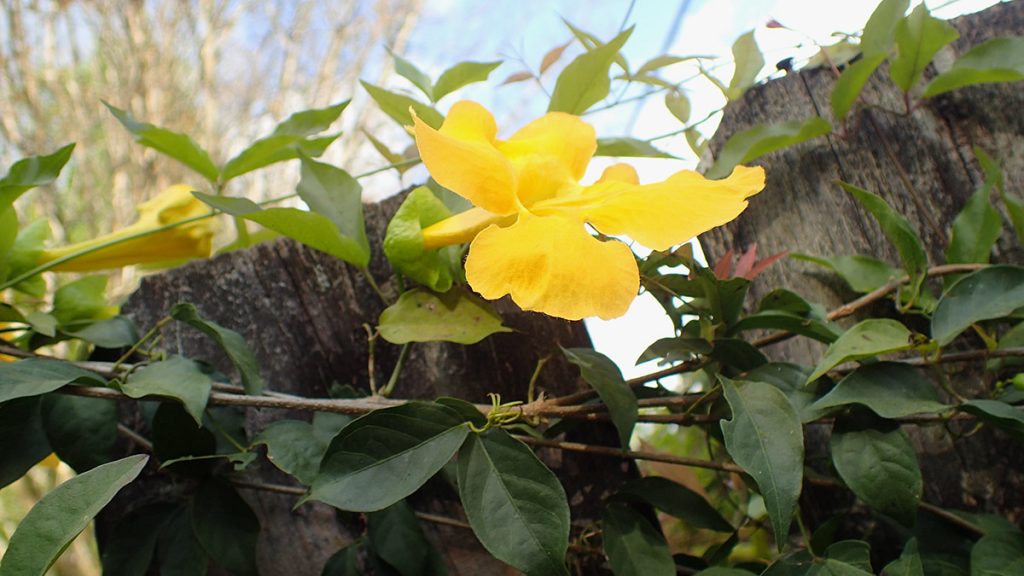
Amy has been on me to clear the vines growing on our fence. We have Virginia creeper and smilax, which are native. I’ve seen birds peck at the vines, and so I figure there are insects. So I figured they added value to the yard. In August, I saw that monarchs used the creeper vine to hide their chrysalides.
But there are also a couple of vines that I don’t know. When this one started flowering, I thought it was yellow Jessamine. But the flowers looked too big, and I had already noticed those blooming as early as January in other locations.
Catclaw vine is not native, and it can become invasive. So this one, I will take down.
Pollinators Part 1: Hoverflies
These are probably all over your yard, and you may never have noticed them. The photos I have are of insects so small, I didn’t notice their patterning until zooming in with a camera. Looking more closely, you can see that they mimic bees with their striped abdomens. And many native bees are about this size, a fact that surprises folks. We’ll see one of those in a moment.
First, I want to talk about hoverfly larvae.
Hoverfly, or Syrphid, Larvae
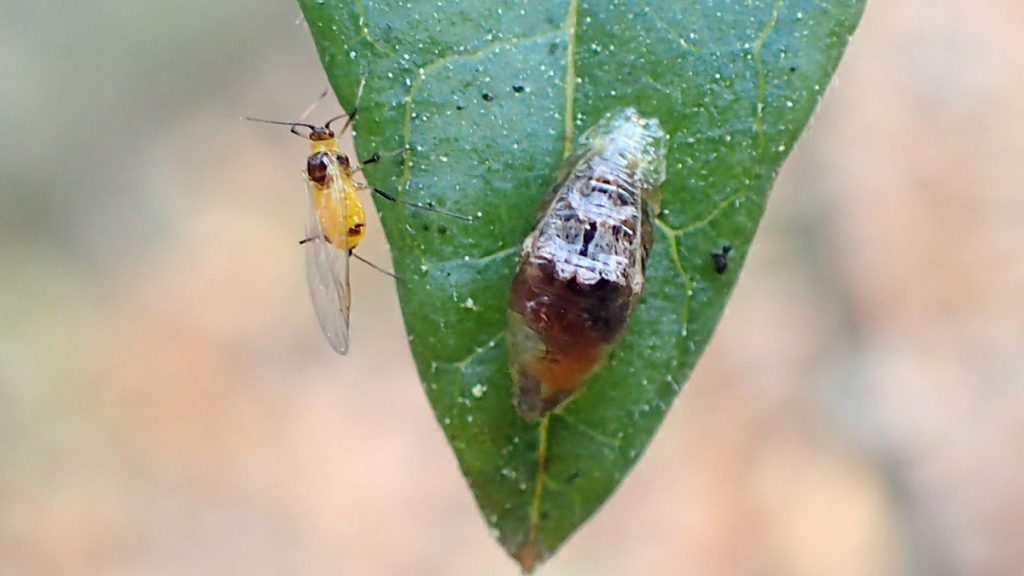
I first noticed this animal on my milkweed plants years ago. I was photographing that year’s monarchs, when I saw this little slimy thing pick up a milkweed aphid and start killing it. Wow. I did some research and learned what they were. Syrphid, or hoverfly, larvae.
At one point, I wondered whether these guys might have had a hand in a bunch of monarchs disappearing, which led me to research monarch predators. Many of those, I found, are otherwise considered beneficial insects.
I’ve never seen a syrphid larvae kill a monarch, and no one has observed this. But this research did shift the way I think about the backyard. To a lot of us, butterfly caterpillars are the stars of the garden. But they’re plant consumers, same as tobacco hornworms, stinkbugs, and even those aphids. Predators control their numbers, all of them, and end up protecting the plants.
Anyhow, syrphids are doubly beneficial insects. Their larvae eat aphids, and their adults are pollinators. This year, I started seeing the larvae on our milkweed in mid-March.
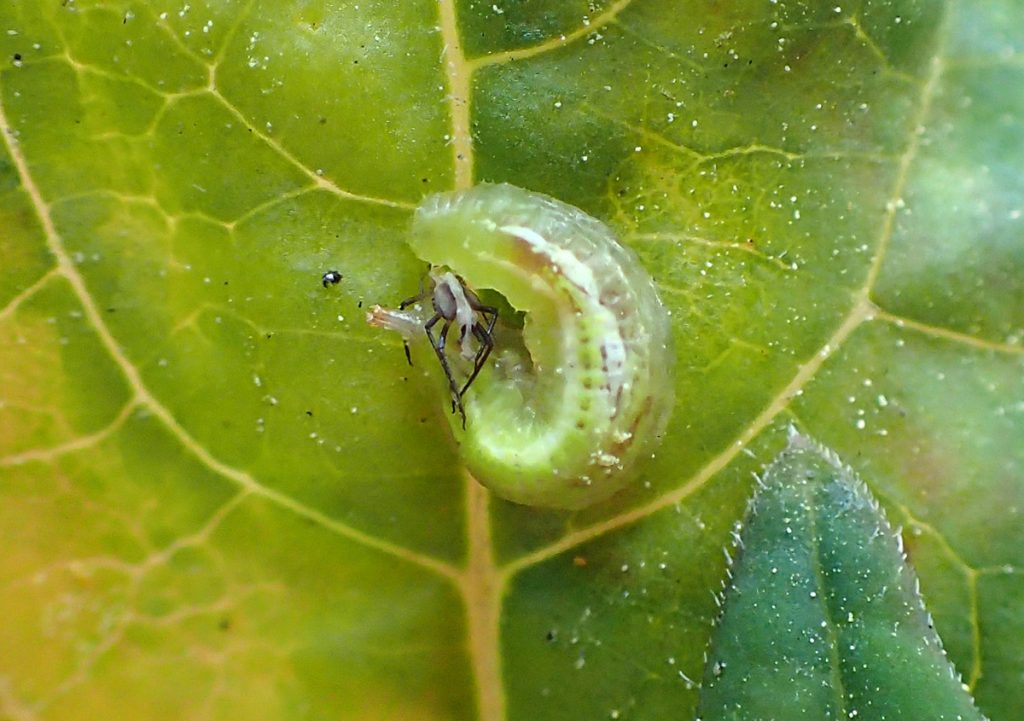
I’ve seen a different species of syrphid larvae alongside different species of aphid on our pepper plants last March. I had at first thought they were caterpillars eating the plant. I iNaturalized both them and the aphids on the plant. When other users identified them as hoverfly larvae, I knew that one insect would take care of the other. And that’s what happened.
Hoverfly adults
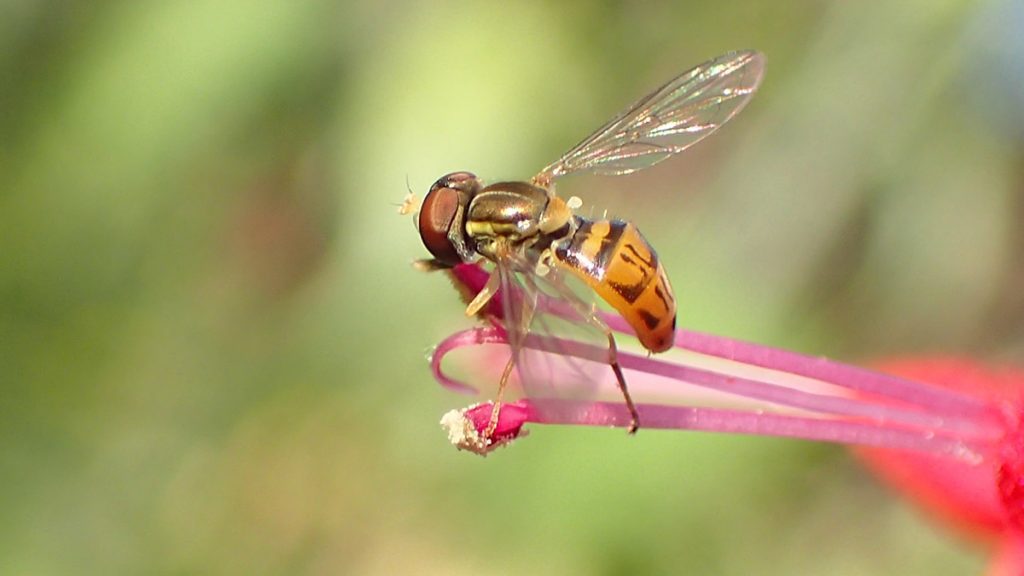
(Toxomerus marginatus).
I identified what I think might be two species of hoverfly, though they may very well be the same. I’ve identified both species in the yard before, so it’s reasonable to expect that I’d see them again. I’m looking here at the pattern on its abdomen.
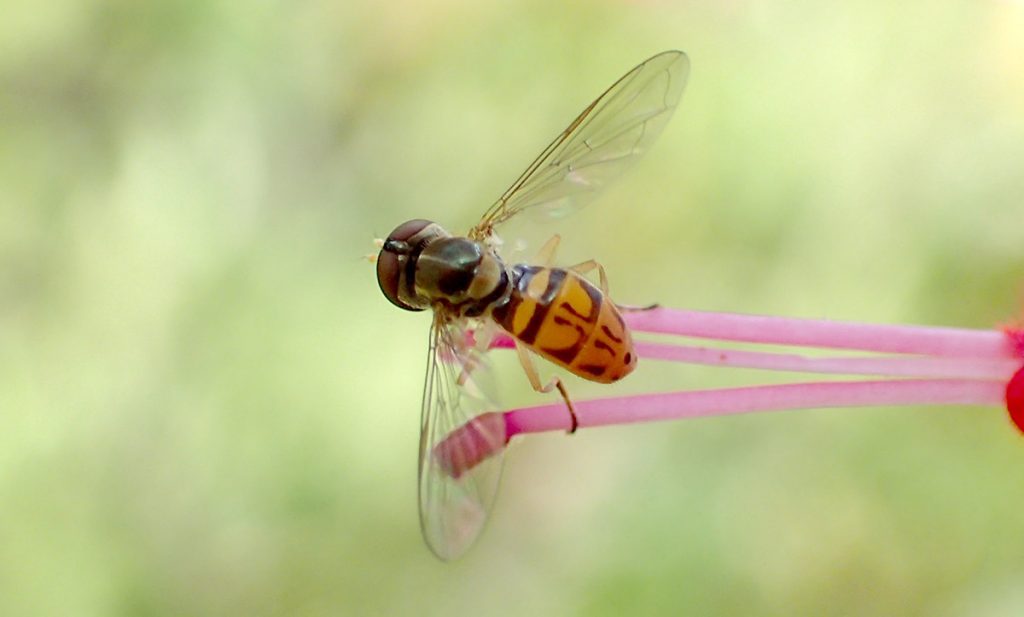
(Toxomerus marginatus) on red salvia.
I was able to get a camera above this on for a better look at the abdomen. My initial guess was thin-lined calligrapher, but another iNaturalist user suggested Margined calligrapher. The calligraphers have subtle differences in their abdominal patterns, but margined calligrapher better matched what I photographed here.
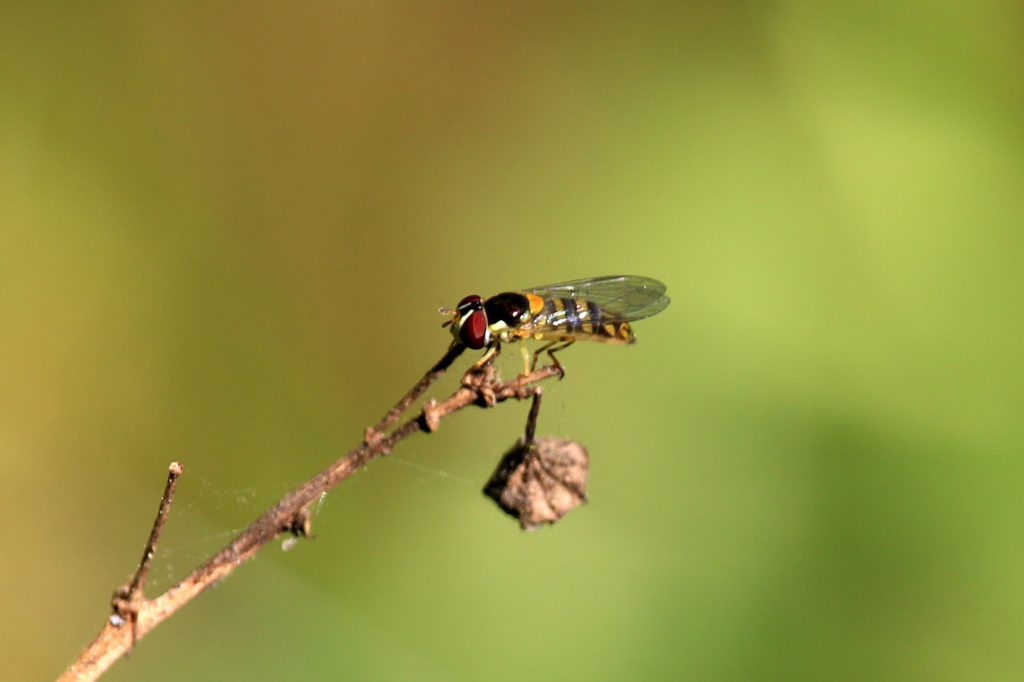
I can see thicker black patterning on this fly’s abdomen. I unfortunately couldn’t position myself above it as easily. This is on a branch with a dead fanpetal flower.
If either of these IDs proves incorrect, I’ll come back and add the correct ID.
Pollinators Part 2: Bees
I’ve already shared photos of our nonnative honeybees and that not great photo of the native carpenter bee. Bee activity has really picked up in March; I’m starting to see more and more bee and wasp species.
And while I can’t say for sure if that’s what the photos below are, I have been seeing more and more holes in bare earth in the yard, which is consistent with bee nests for many species.

Maybe a bee nest? 
Large hole in the ground, possibly bee nest?
Those photos are from earlier in March. Later on, I started seeing oak pollen and other detritus stuffed in the holes. Is this some form of camouflage, or do we really have that much pollen falling right now?
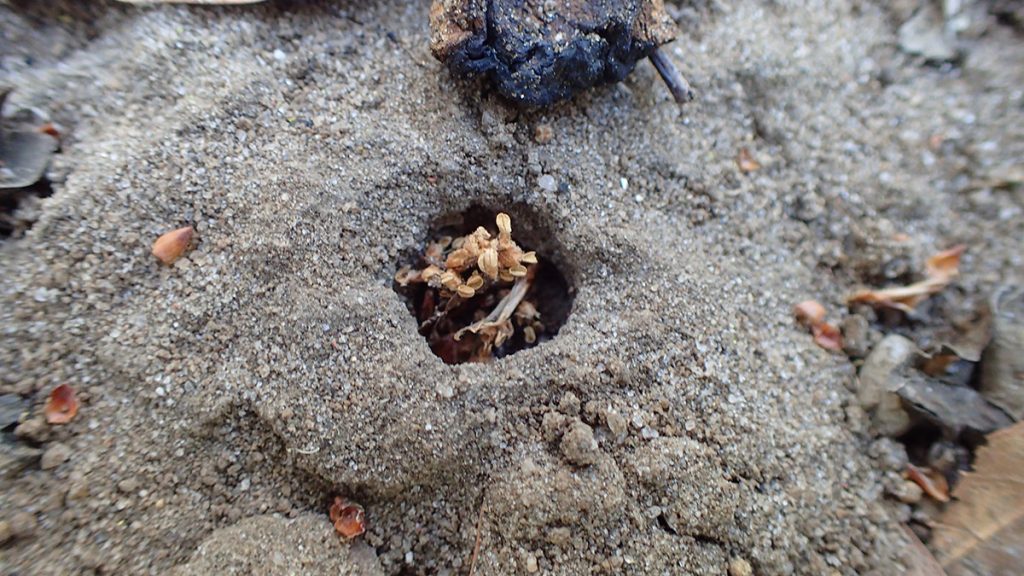
I did see this bumblebee pollinating our blueberry bushes:
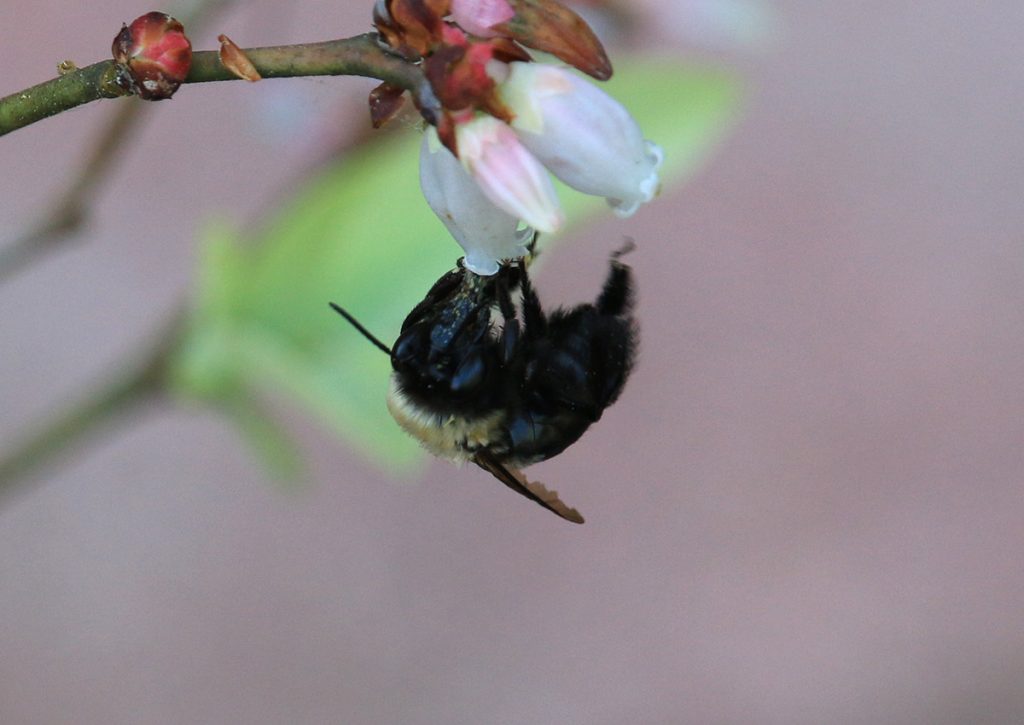
This is the more common eastern bumblebee (Bombus impatiens), a ground nesting bee. Late last summer, we met the American bumblebee (Bombus pensylvanicus), a rare species, though it was once the most common in the United States. That larger bee builds its nest aboveground, and one reason it might be in decline is that its nests are more vulnerable than ground nests.
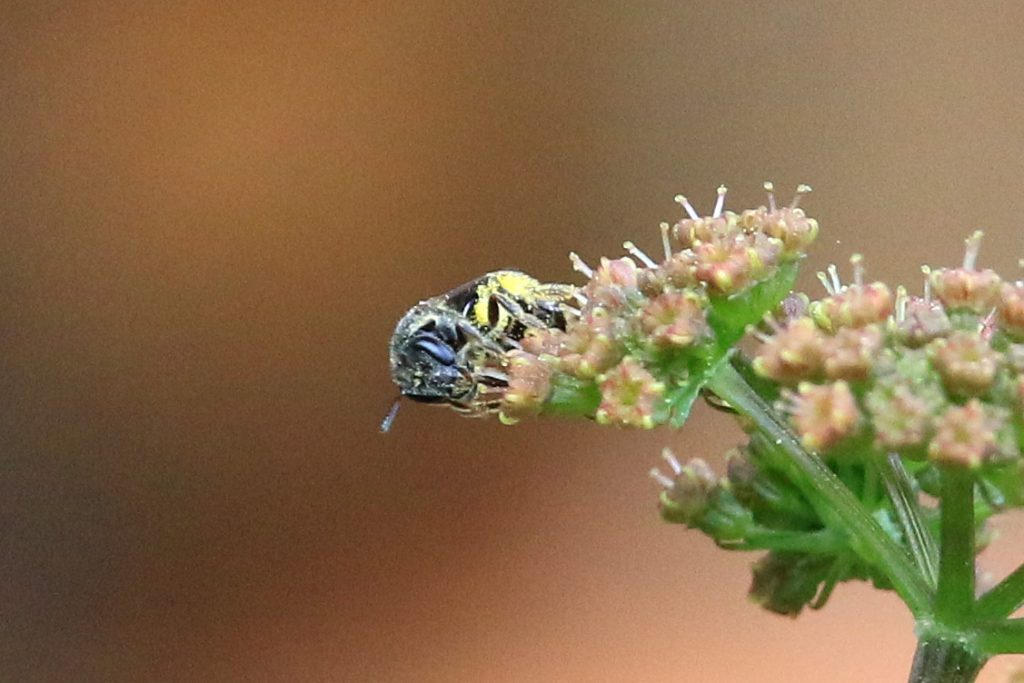
I saw the this small critter on a meadow parsnip flower. This plant is in the carrot family, and as such is a larval food for black swallowtail butterflies. As you can see in this video I produced last year, from a season’s worth of black swallowtail footage, fennel had been my larval food of choice for the butterfly.
But that’s an nonnative food plant. The members of the carrot family we grow to feed ourselves- dill, parsley, fennel, and of course carrots- are crops brought here from the Old World. This year, I wanted to try a few natives alongside the fennel, two meadow parsnips and two golden Alexanders. They’re flowering, which I hope attracts the butterflies. I know that caterpillars tended to go to the fennel flowers early on in their development. Our monarchs do this on milkweed as well, hide themselves in the flowers during early instar phases.
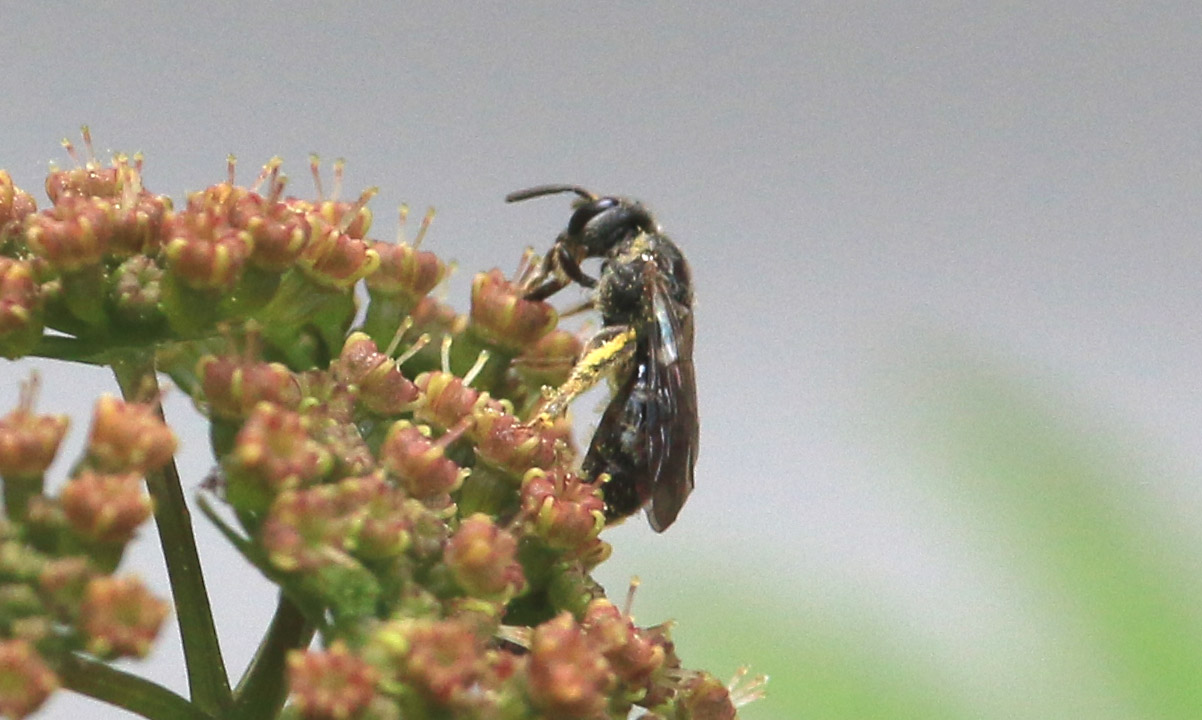
This is a very small bee. Comparing it to other bees found in our area using the “compare” feature on iNaturalist, I’m fairly certain this is a Poey’s furrow bee. This is a type of sweat bee I saw often last year. EDIT June 2020– more likely a small metallic sweat bee in the subgenus Dialictus. Poey’s furrow bees are closely related, but have a much larger head and striped abdomen. And they’re a little bit larger than this bee.
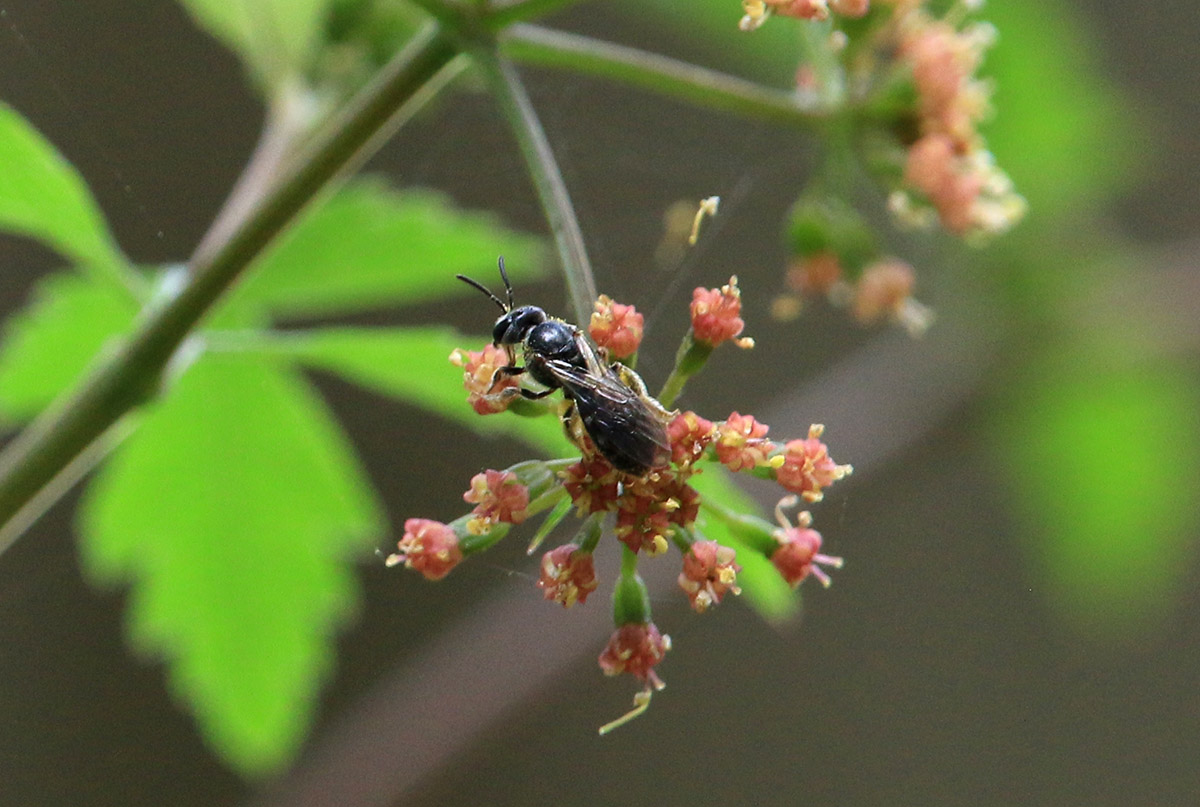
Pollinators Part 3: Wasps
Wasps get a bad rap, but they’ve grown on me. Part of the reason for this is that as you start paying attention, you’ll see that they’re a diverse lot. Contrary to what some people think, they are pollinators. But the larvae of many species eat caterpillars. I have seen wasps carry off younger monarch caterpillars, and I didn’t like that. But they also take care of a lot of “pest” species as well. Again, predators provide balance.
Like with the bees, I started seeing wasp species in the yard in March.
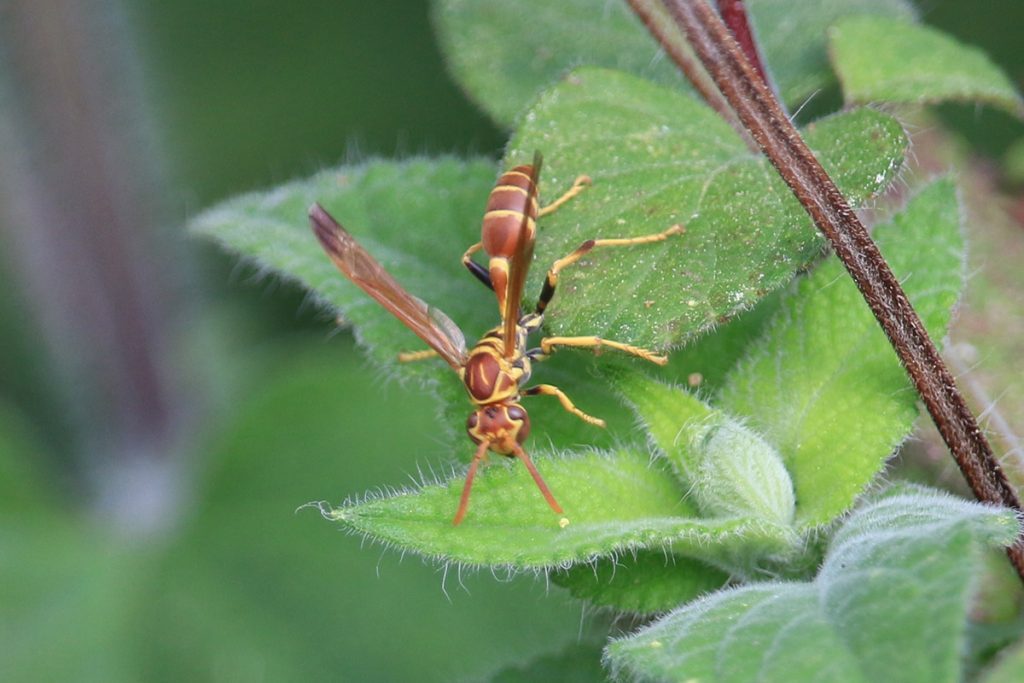
Here’s one of the species I’ve seen carrying off monarch larva to feed its young.
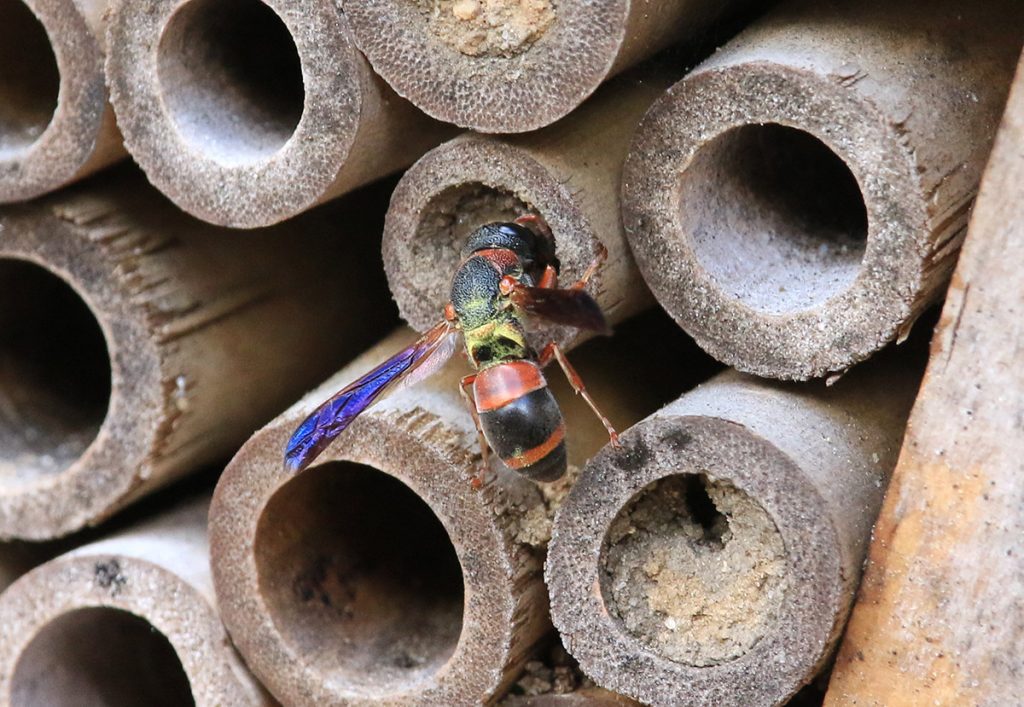
This wasp was common in our yard last year. And they’ve made good use of the bee nest box Amy bought. Reading about mason wasps, they build their nests in a variety of places. They look for cracks in wood, or abandoned beetle burrows. They also dig holes. And they repurpose other nests. I’ve seen four-toothed mason wasps make use of an old carpenter bee nest.
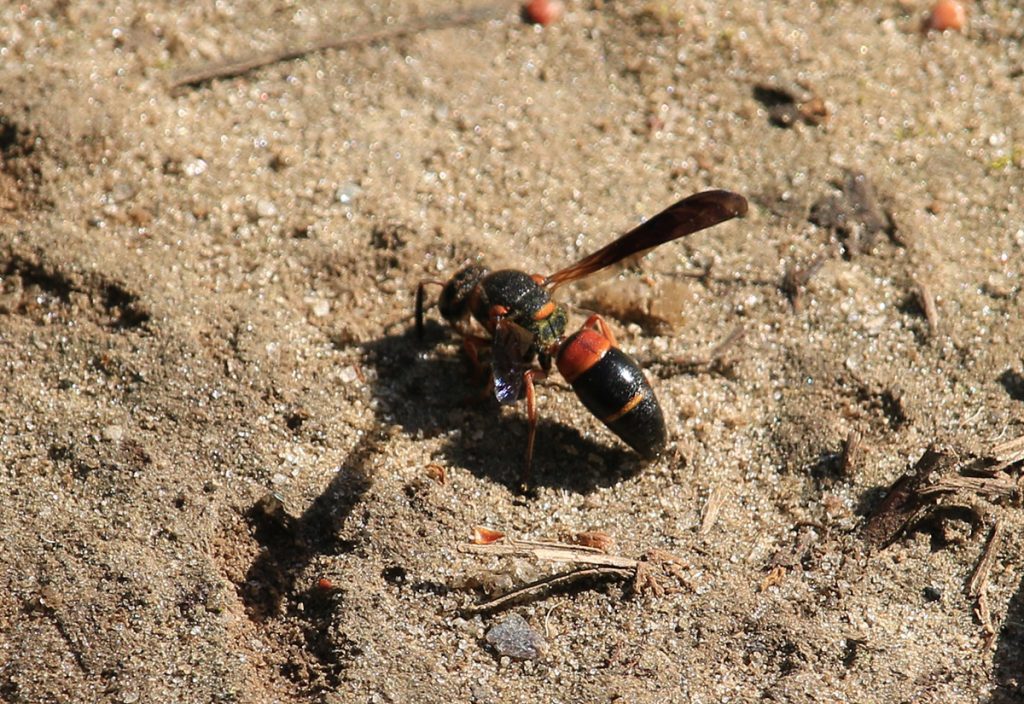
I wonder if this pachodynerus wasp was looking to dig a burrow. Or maybe it was searching for food? No, more likely, it was gathering earth to seal its nest.
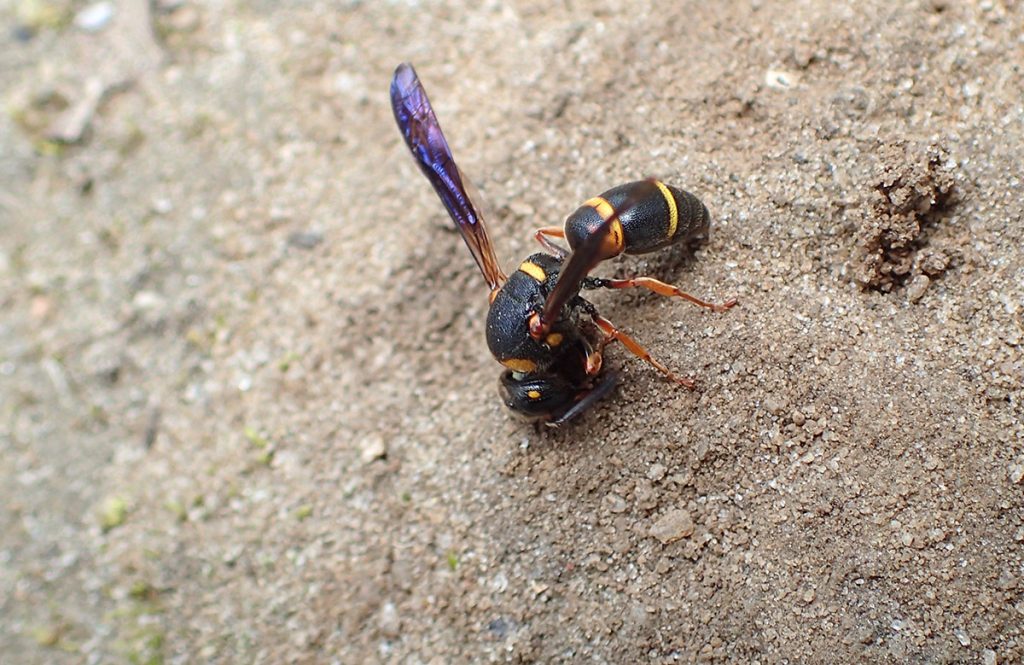
The next day, I saw another species of mason wasp searching the same spot. This is an interesting species. My initial ID was Euodynerus schwarzi. Then one user tagged another user. This is when things get interesting on iNaturalist. The tagged user recommended Euodynerus foraminatus-complex, with a lengthy comment. To summarize, Schwarzi has white markings, and never red legs. They called it a “very difficult species complex,” saying “This might be a Floridian form of blakeanus or leucomelas or an undescribed species. It also bears a strong resemblance to the Texan fedoris. Further research is required.”
It goes to show how our understanding of the natural world is always evolving. “An undescribed species.” Wouldn’t that be cool to see in my yard? I hope I get to see it again.
Pollinators Part 4: Butterflies
I’ve seen a lot of butterflies pass through the yard, including black and giant swallowtails. I keep hoping to see eggs on our carrot family plants or Meyer lemon tree, their respective larval foods.
So far, no luck.
What I have seen plenty of is monarch butterflies. Our non-winter has perhaps kept the a population here year round, rather than see them complete their migration to Mexico. Multiple vacations in the winter let my nonnative milkweed get a little leafy, and we had three chrysalides which failed due to OE in January. I kept the leaves down in February, but I’ve been letting them grow again in March. By March 14, I saw all of this:

Monarch egg on milkweed. 
First instar monarch caterpillar under a milkweed leaf. 
Monarch chrysalis.
My eye was drawn there by an adult monarch flying through the yard. So I wasn’t surprised to see an egg. At no point have we had an abundance of leaves, but it seems that in yards across Tallahassee, monarchs have been laying eggs more or less continuously through the winter. It’s troubling, since mortality is so much lower during these months. But we are perhaps past having OE on our milkweed leaves:
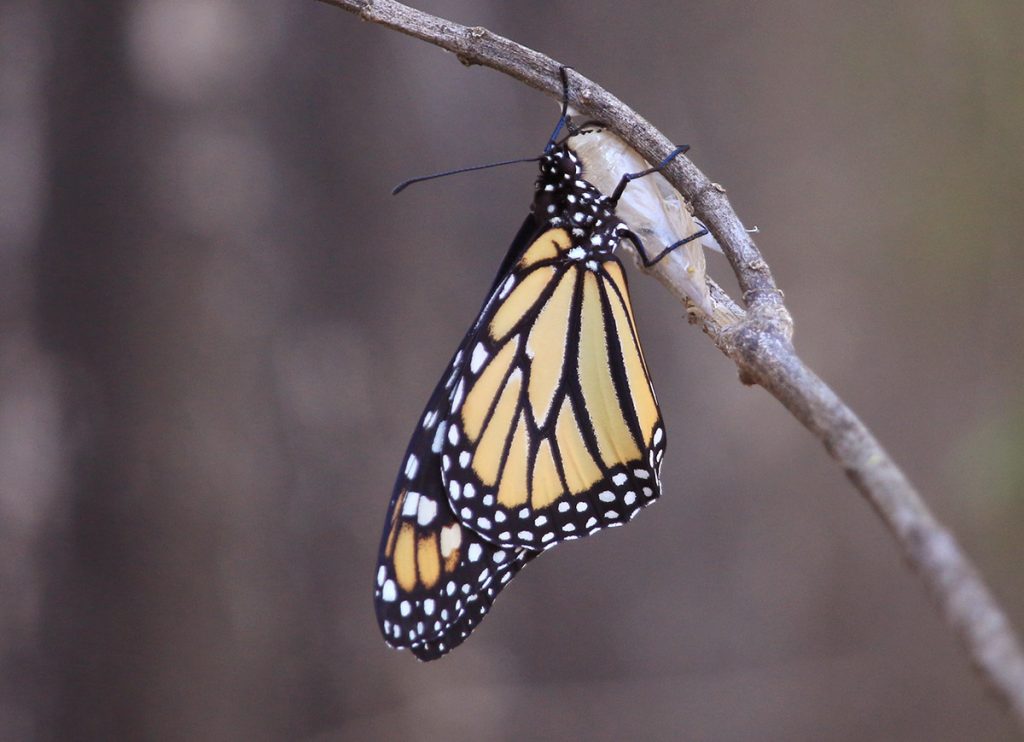
In late March, I spent some time following this fifth instar caterpillar, likely searching for a place to spin its chrysalis.
The Bell Pepper Plant Ecosystem
Since I’ve started paying closer attention to the insect life in my yard, certain plants have had a surprising amount of diversity on them. The Meyer lemon tree and our bell pepper plants have especially interested me. I think it’s that they’re larger and leafier than many of our wildflowers, and yet they’re much smaller than trees, and the everything that happens on their leaves are closer to eye level.
Sometimes, you see a clue of animal activity:
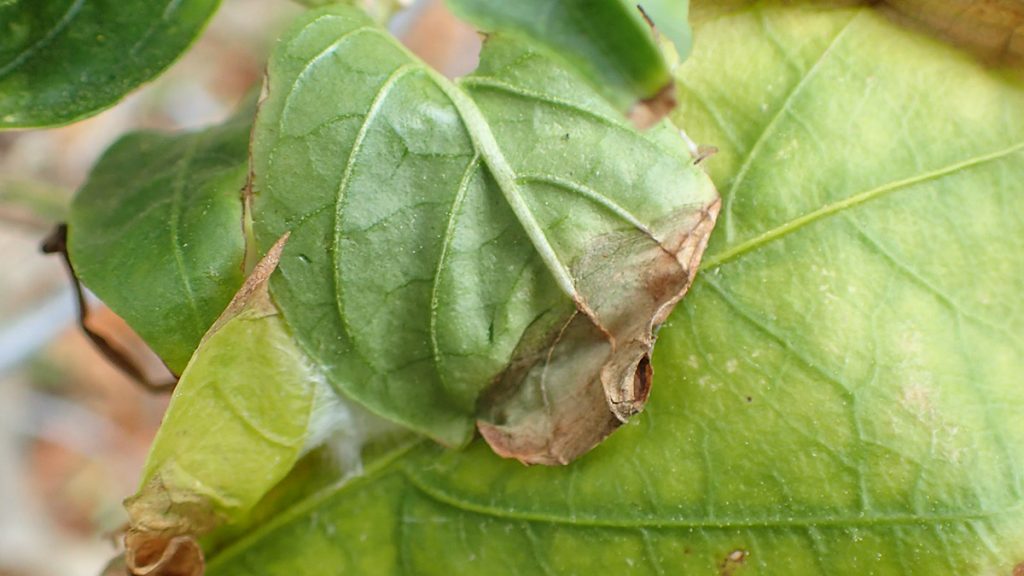
Something stuck these two leaves together. This looks intentional. And though it’s rude to do so, I wanted to see what was inside:
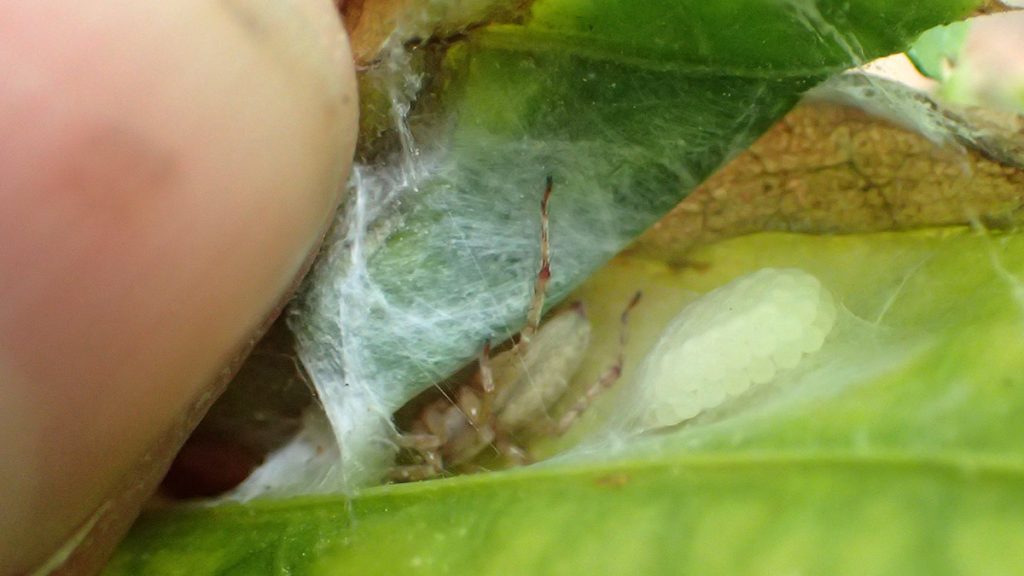
I did my best to take this photo quickly and let the spider get back to caring for her brood. The hasty manner in which I took the photo kept me from getting a photo I could use to ID the spider. Still, neat to see this on our pepper plant.
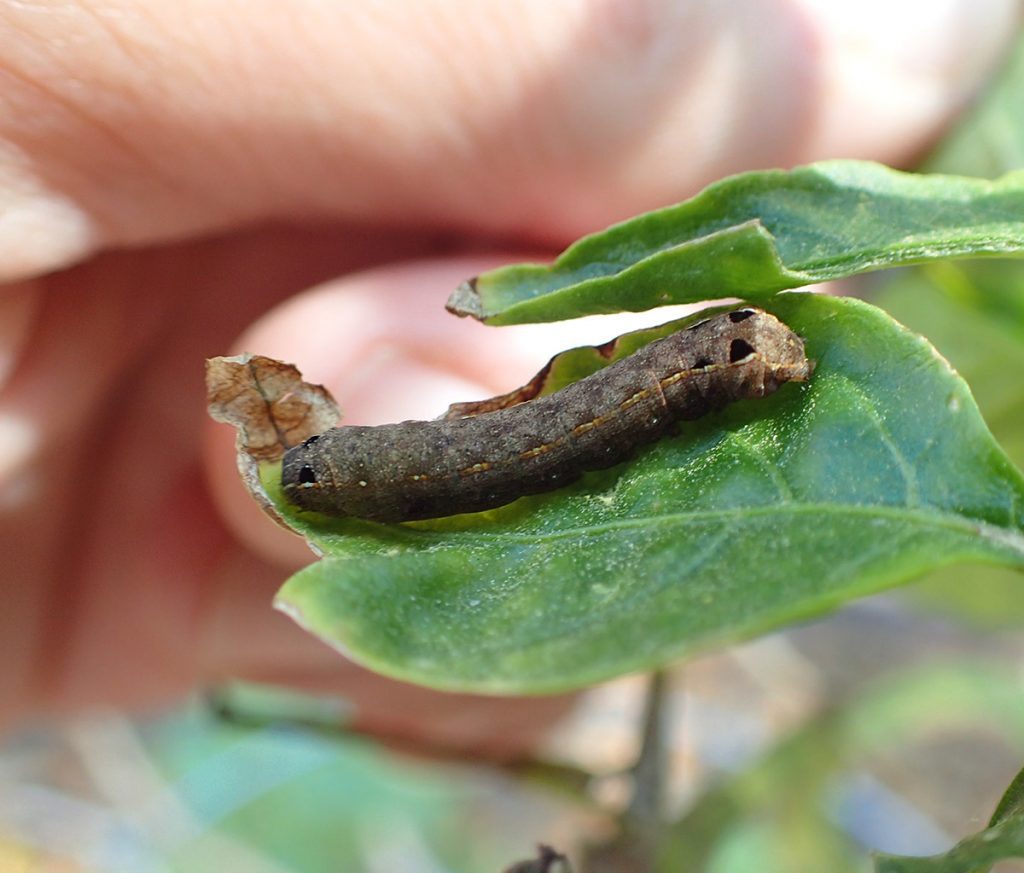
Here is a much less welcome visitor on our plant. This is the archetypal pest caterpillar, a cutworm, or armyworm. Unlike most butterflies and a lot of moths, whose caterpillars eat only certain host plants, armyworms are generalists. They eat a lot of things, and you’ll find them on a lot of different plants. I tend to leave isolated cutworms alone, as they are a part of our yard’s food web. I never saw this one again, and the plant remains leafy with many flowers and small peppers.
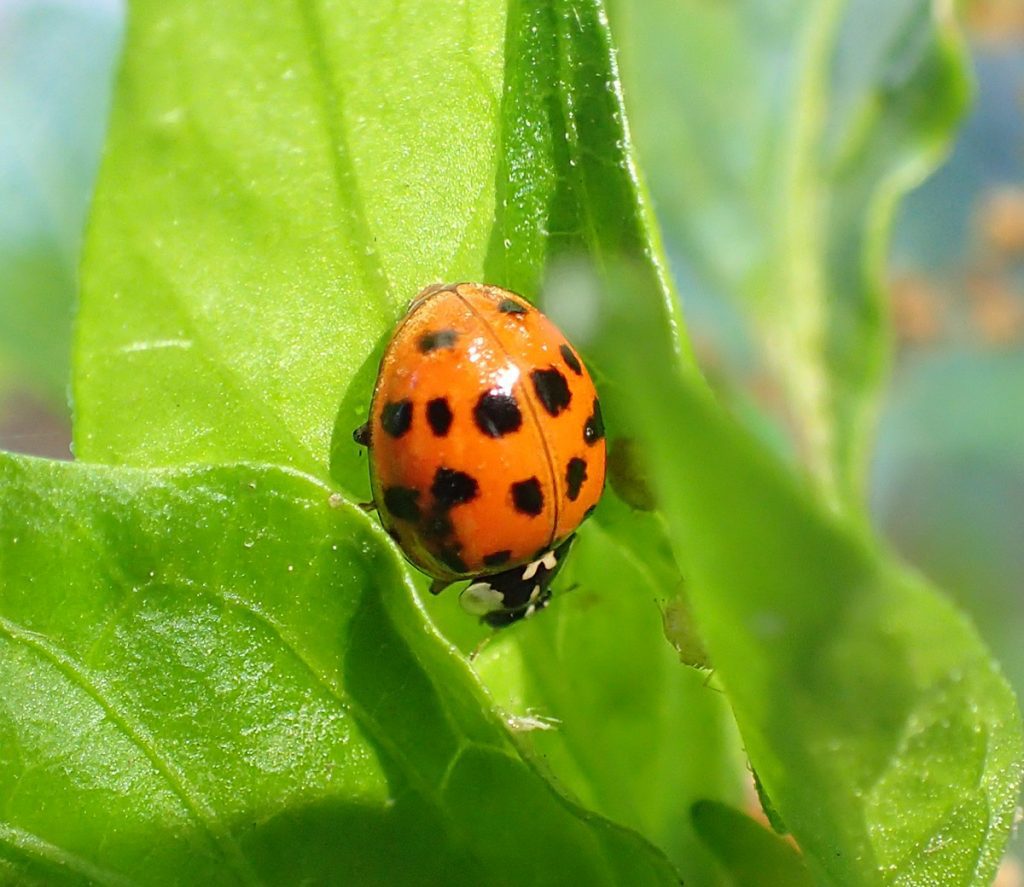
Sadly, most of the ladybugs I see in the yard are not native. These vary in their look, which has thrown me off in the past.
I couldn’t find a lot of information on this one, which is not uncommon for insects with no common name. It was hopping from leaf to leaf, and one time flew up to a higher one. The one thing I found said this was an ant mimic.
Other Critters in the Yard
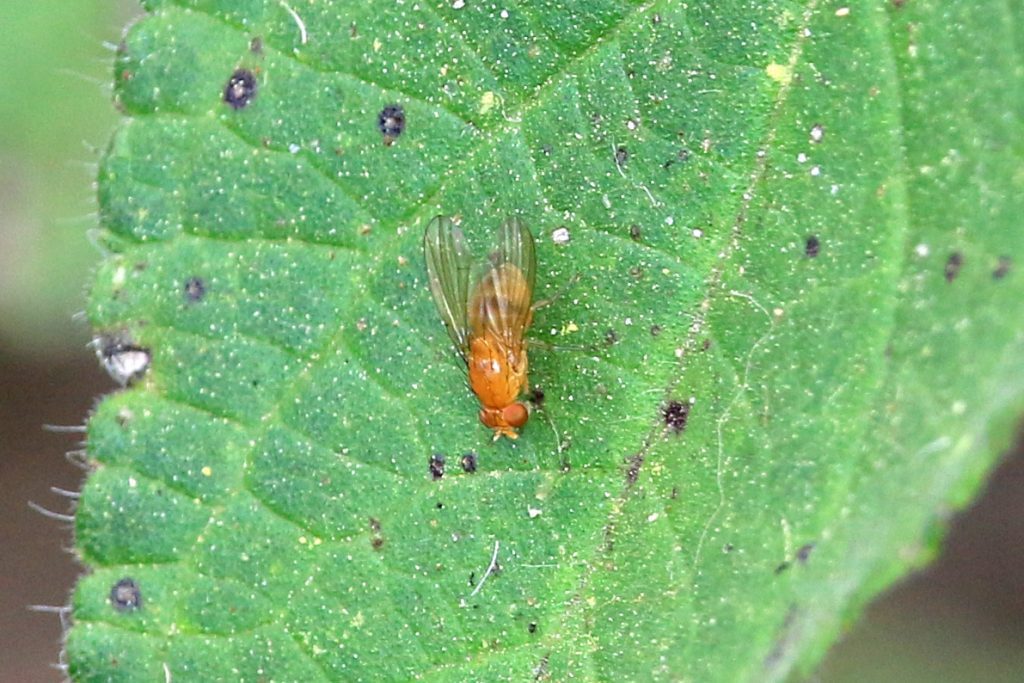
No one has confirmed my initial iNaturalist guess for this little orange fly. If you take a closer look at the flies in your yard, you’ll notice a wide variety of colors and shapes.
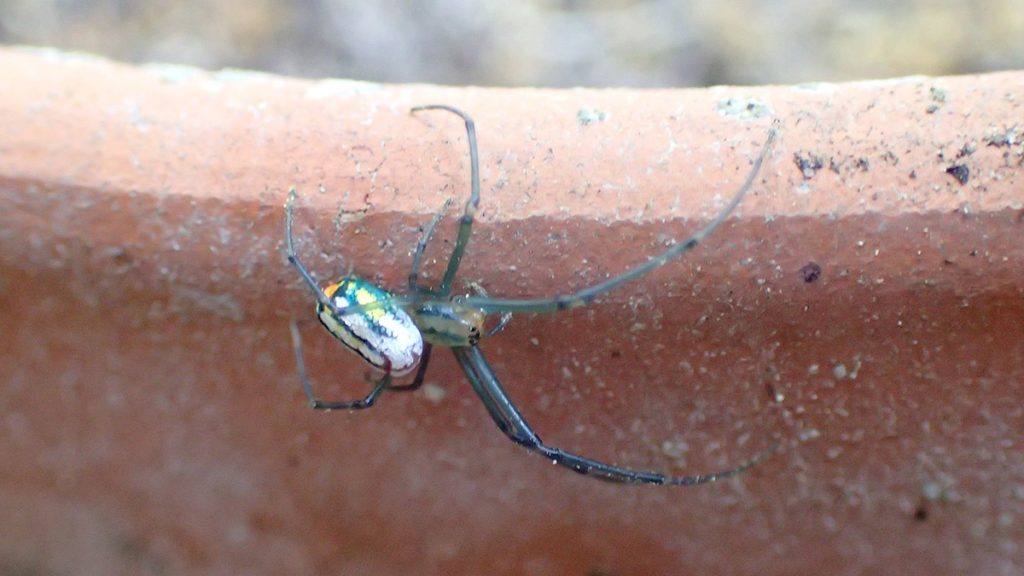
I see these spiders all over the yard. And now I know what they’re called.
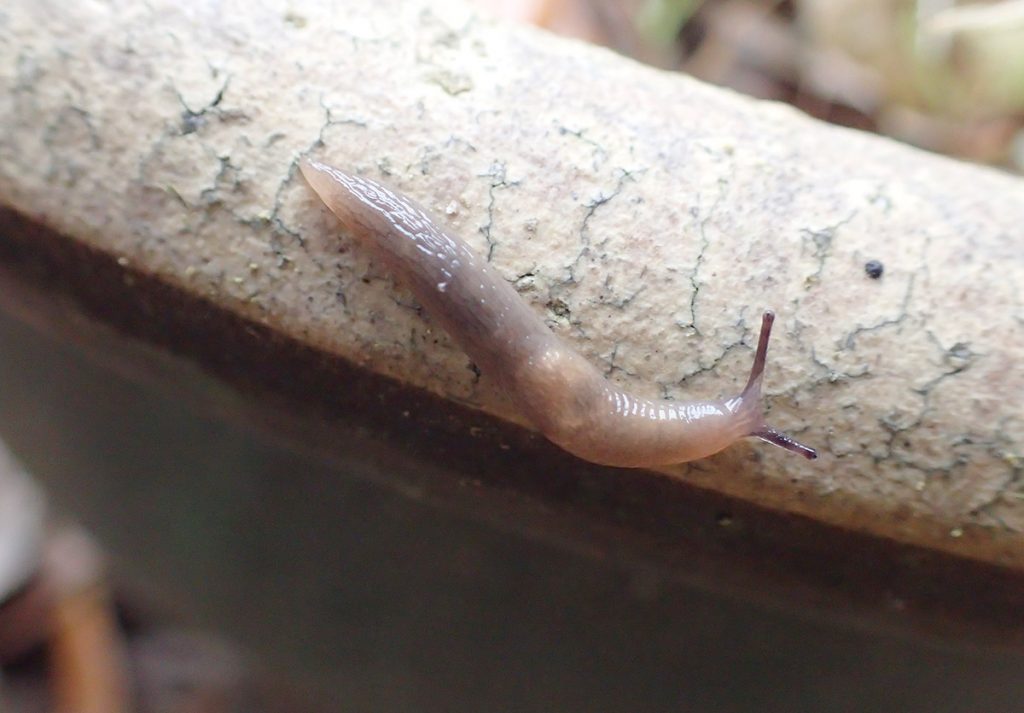
This slug is on a milkweed pot. Early in the monarch migration season, in most years, I start looking at my milkweed for signs of caterpillars. I usually find these guys eating the leaves first.
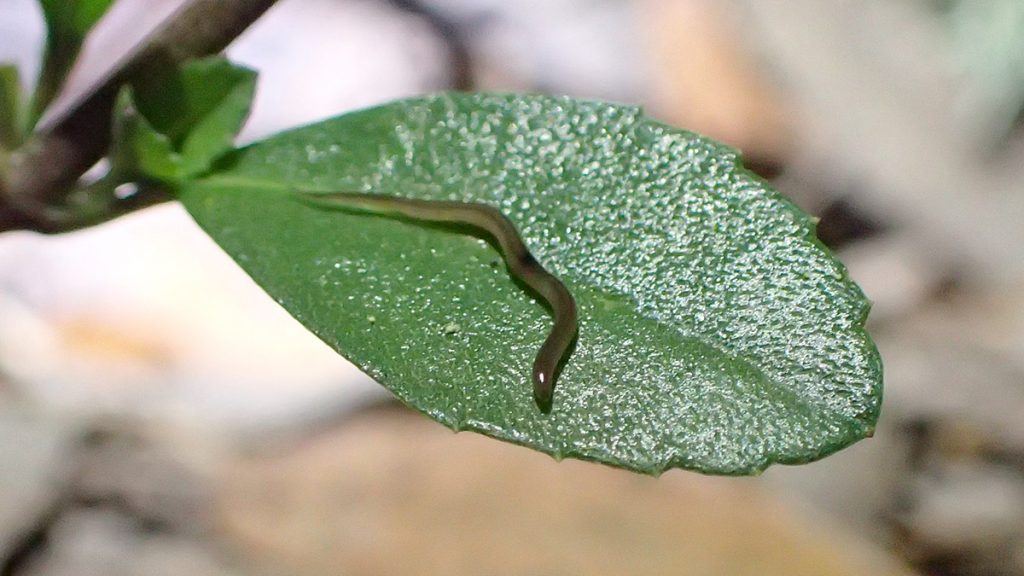
Something was eating the turkey tangle fog fruit I planted, and I was hoping it was a phaon crescent butterfly caterpillar, which hoist on this native groundcover plant. I went out one night in search of this plant consumer, only to find what looks like a skinny slug?
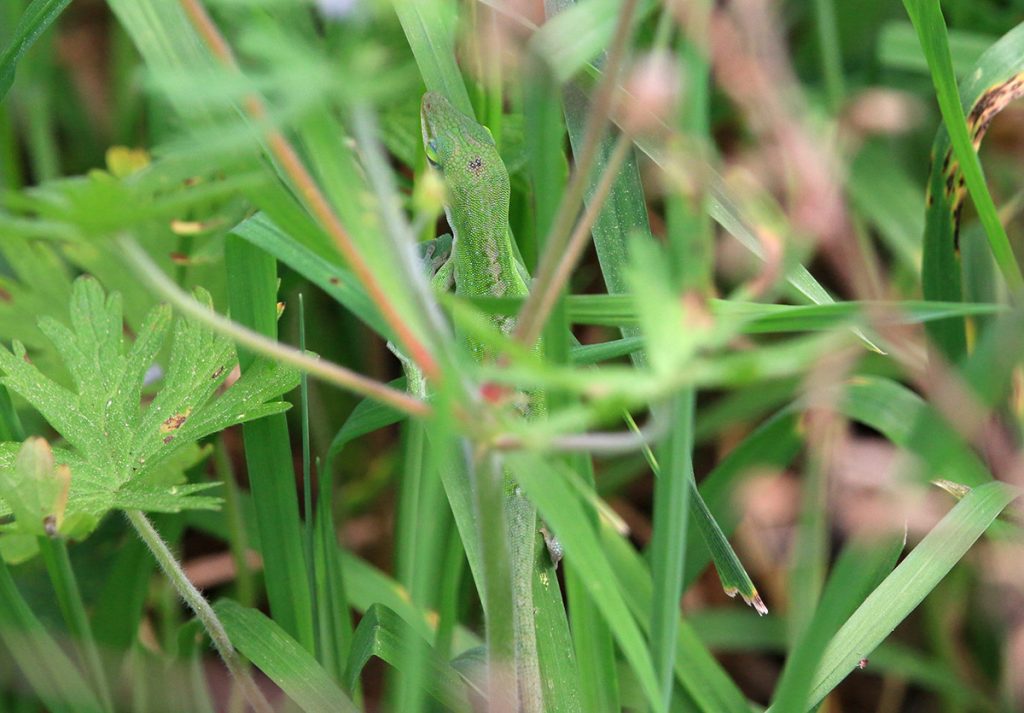
Now that’s some good camouflage.
And finally, regrowth in the yard
I like to take note of when our native wildflowers bloom in the yard, as they have their seasonal schedule. Part of that cycle, for many of the plants, is dying back in the winter and regrowing from the roots in the spring and summer. Here are a couple of the plants that started releafing in February:
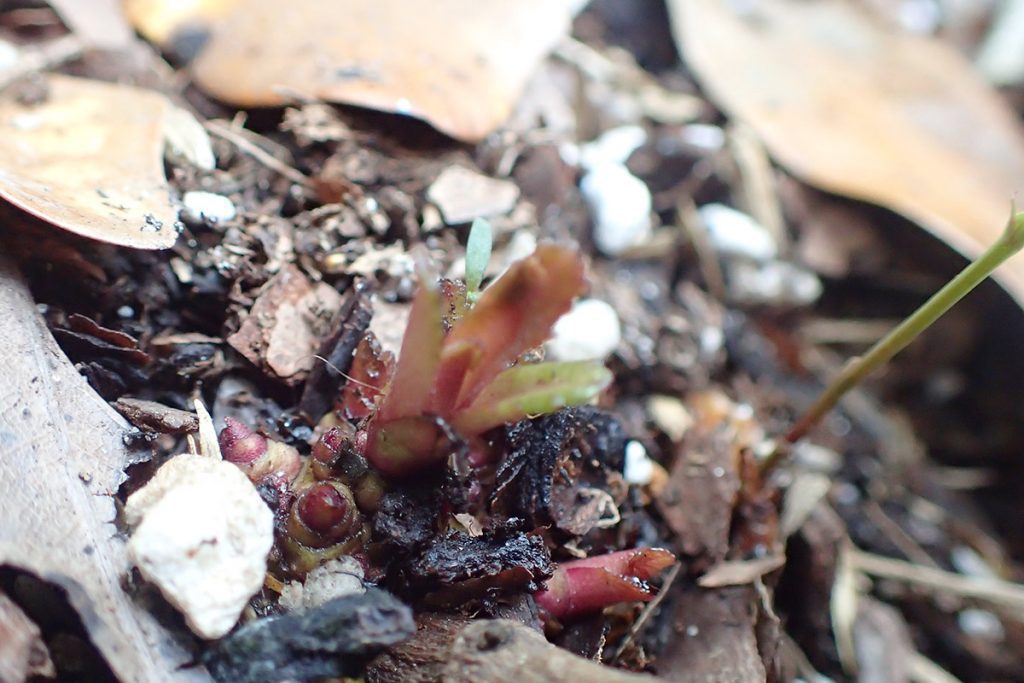
At the time I’m writing this, at the end of March, both of our ironweed plants are getting pretty tall.
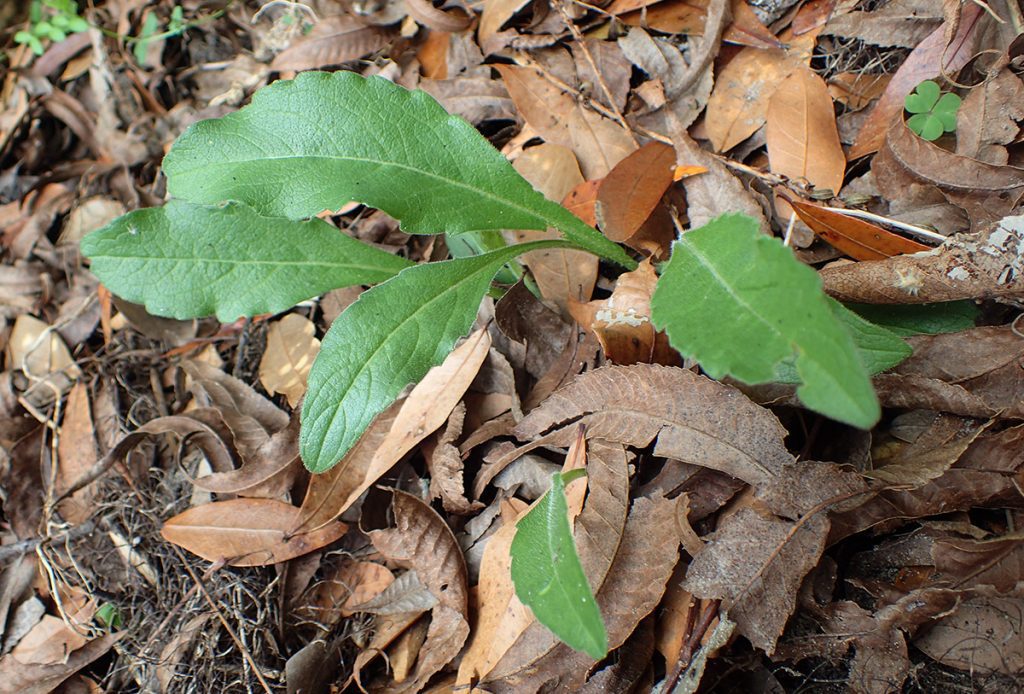
I bought two of the plants above on the advice that, once they were established, they were pretty drought tolerant. I planted them during that nasty seven week drought that spanned the end of summer and beginning of fall. They didn’t make it, but luckily I didn’t plant anything in their spot. Now they’re regrowing.
And lastly, not a regrowth, but a plant on the way out. Right before I swapped out my winter food plants for summer seeds, the last of my arugula bolted and flowered. I don’t often get to see these, so I thought it was neat:
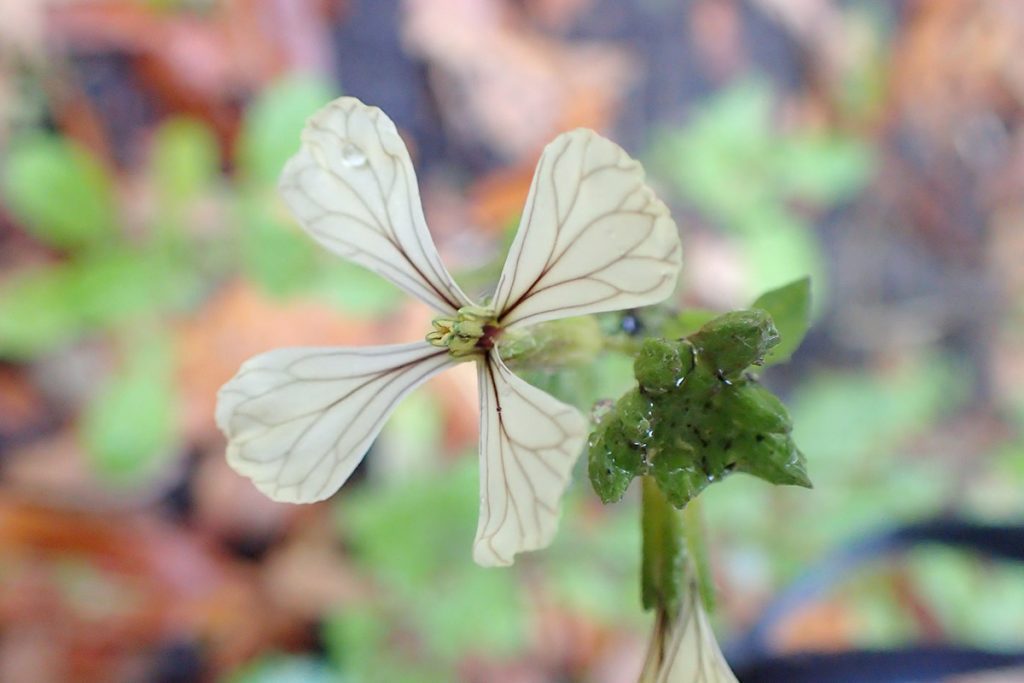
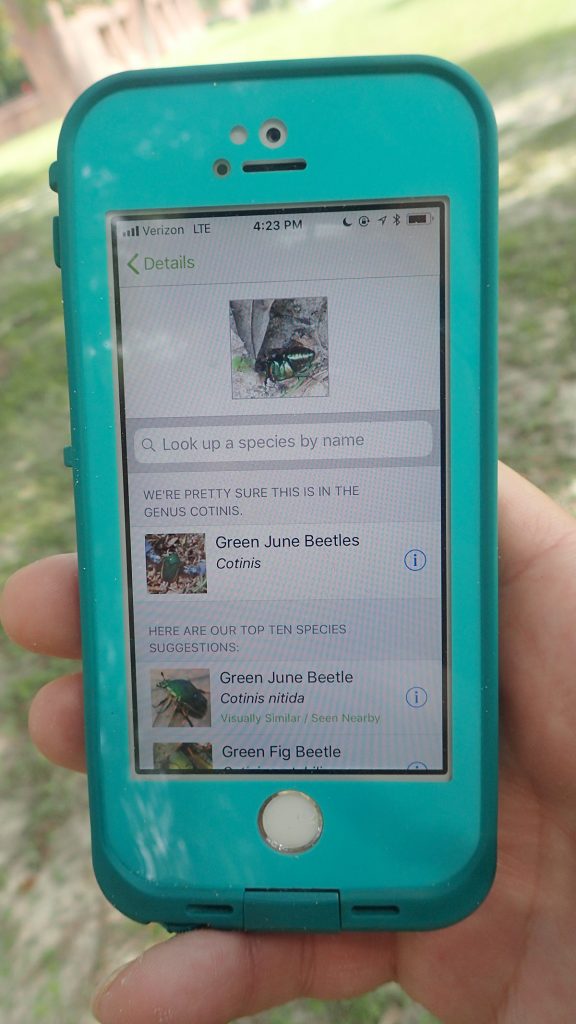
Apps and Citizen Science mentioned in the Backyard Blog
iNaturalist
Identify plants, animals, lichens, and fungi in your yard. Other users correct your identifications if you’re wrong, and even if they don’t, it can be a good springboard to further research.
Seek by iNaturalist
Instant identification, and it doesn’t record your location. This is a good option for kids with phones.
Monarch Larva Monitoring Project
Enter information about monarch caterpillars in your yard, and help researchers get a sense of the health of the monarch population that year, and how and when they’re migrating.
Great Sunflower Project
Record the number of pollinators visiting your flowers, and help researchers map pollinator activity across the country.
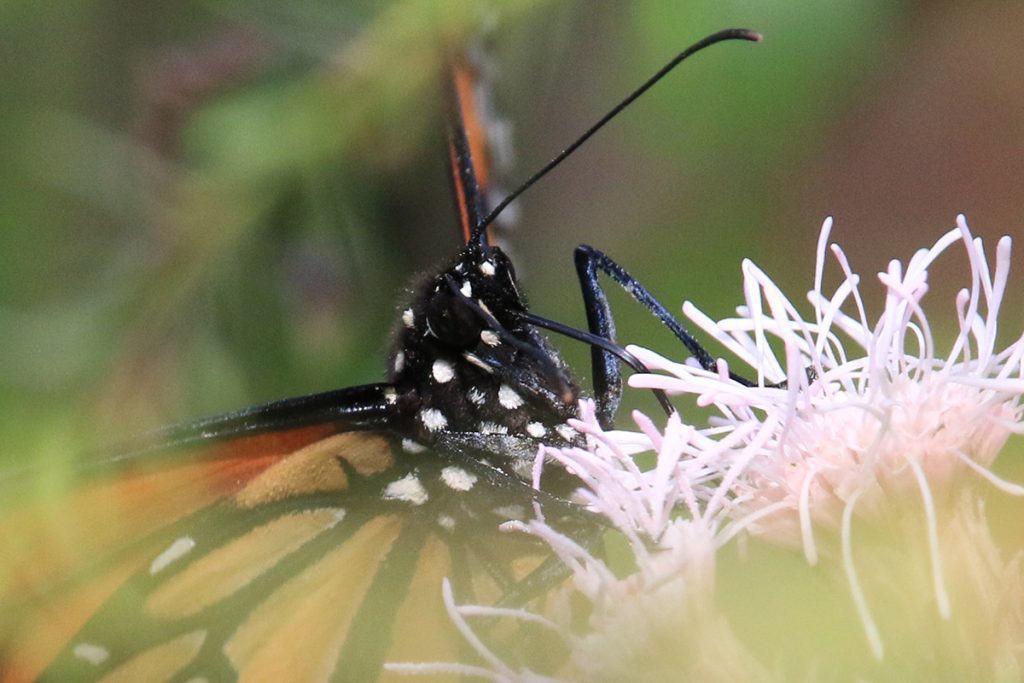
Dig Deeper into Backyard Ecology
What can we do to invite butterflies, birds, and other wildlife into our yards? And what about the flora and fauna that makes its way into our yards; the weeds, insects, and other critters that create the home ecosystem? WFSU Ecology Blog takes a closer look.


